En el desierto de baja altitud de Arizona, los céspedes de temporada cálida (césped bermuda, césped zoysia y césped San Agustín) entran en estado de dormancia y típicamente pierden su color verde durante el invierno. La sobresiembra de césped bermuda con un césped de temporada fría proporciona un césped verde durante todo el año. Un césped invernal sobresembrado proporciona un paisaje estético y funcionalmente ofrece un césped recreativo.
Publication
Roper was, as his name suggests, a team roping horse in his former life. He now enjoys the majority of his days, at age 22, as a roany-pony pasture ornament. When he is ridden it sometimes feels like he has a little “kink” in his back and needs some round pen time with the saddle on for some good bucks before mounting. He also has some stringhalt (exaggerated lifting of hind legs) at times when he is getting warmed up and is occasionally found leaning against his stall wall when he spends time inside. When the opportunity came up to see what a chiropractic evaluation and treatment would find/fix, his owner jumped on it.

Figure 1: Roper at 16 years old riding down the wash in Tucson, Arizona.
Betsy Greene
Why do horses need chiropractic care?
Horses are incredible athletes and can perform well with many handicaps and minor issues. Whether these issues come from overexertion or overuse from long term riding or competition, rough play with pasture mates, or even a “bad roll” over a rock in the pasture, aches and tweaks can occur. Like humans, horses will compensate by “not using” or not flexing the part that is sore or painful. The more they compensate, the less flexible that joint will become. Ultimately, that joint restriction, whether it came from the injury or the avoidance, results in what chiropractors term a vertebral subluxation complex (VSC). These can cause handicaps that inhibit movement, create pain and discomfort, and reduce performance. Older horses are more susceptible to loss of spinal flexibility and muscle strength, contributing to a lack of performance or increased discomfort and poor mobility. That is where chiropractic work may be able to come in to relieve pain and restore freedom of movement to the locked up joint. Chiropractic manipulation, or adjustment, treats the VSC thereby restoring the spinal cord’s function and improving the animal’s comfort and performance. The best yet is that chiropractic adjustments are drug free. This article will explain the steps of the full equine chiropractic visit, from start to finish. We will be using a sandwich as our analogy, as we all know how satisfying a well made sandwich can be!
A solid and complete chiropractic treatment for your horse will include much more than just loud “bone cracking” and leg pulling and/or jerking. It begins with a detailed history of your horse’s actions and activities, a thorough evaluation of the horse (both moving and standing), chiropractic adjustments to the problem spots, and a treatment plan for getting and keeping your horse comfortable with a healthy freedom of movement. The chiropractic process needs all of these components to provide the most effective treatment and potential long term benefit for your horse. Without all of the parts of this chiropractic “sandwich”, your horse will not have the best opportunity to improve.
The basics of veterinary chiropractic
The complete sandwich
Veterinary chiropractic is a method and philosophy that works to restore and maintain a properly functioning neuromusculoskeletal system through joint manipulation. In order for the nerves to be able to provide information from the brain to the rest of the body, normal things must occur. Healthy blood flow and circulation must be maintained so that the muscles, joints, and spinal discs receive the oxygen and nutrients they need. This allows for normal joint movement. When an animal loses normal flexibility of its joints it will result in stiffness and muscular tension. Vertebral subluxation complex (VSC) is a technical term for a joint that is not fully functional, limiting mobility. The chiropractor is essentially using their hands to restore function to any VSC found during evaluation. The goal of chiropractic treatment is to address neurological dysfunction in the spine and restore mobility.
How long does a chiropractic visit take?
A typical treatment takes between 30 to 60 minutes including: collecting a history, evaluating the horse, adjusting the horse, and formulating a plan. New horses will take longer as the doctor will take time to understand the horse’s history and issues. The horse's willingness to participate, aka stand still, during examination and adjustment also influences the length of time.
How to assess a horse
Background information
Bottom bread slice
The horse’s background information is where everything starts, just like the bottom piece of sandwich bread. The doctor will gather information from the history to get some clues on areas the horse might need assistance. Other important details include the signalment (e.g. age, breed, gender), and the types of riding, training, showing, etc., that the horse is used for and how often.
The age of the horse influences how agile their joints and tissues are. Certain breeds may have a different number of vertebrae in their body (e.g. Arabians). The riding discipline and the type of environment the horse lives in provides more information to put the full picture together. Does this horse need to stop hard and fast, be able to jump high, or have excellent strength in its head and neck? Does the horse carry unbalanced riders such as lesson horses and therapeutic riding horses? Is there a chiropractic issue that is preventing this horse from performing its job?
Is the horse a candidate for chiropractic/spinal manipulations?
Another important first step, before the doctor puts their hands on the horse, is determining if chiropractic adjustment is safe for that animal. Foals, geriatric horses, pregnant mares, performance horses, pleasure horses, and horses recovering from an injury can all benefit from chiropractic care. Horses that are unstable on their feet, fall over easily, have a fever, illness, or acute major lameness that has not been diagnosed, are NOT candidates for a chiropractic adjustment.
Gait analysis and palpation of horse standing still
Lettuce and mayo
After gaining a thorough history (bottom bread slice), the chiropractic exam is next. This may incorporate facets of veterinary medicine, however we will be focusing on details that pertain to the motion of the body. The chiropractor will observe the horse’s stance in detail. Does he stand square and at rest without pointing or camping out his legs? How is his muscling along the axial skeleton? Does his spine have lordosis or kyphosis ? Are there any bones that appear to be enlarged or feel different than normal (“hunters bump”, “knocked down hip” etc). Scars, swollen joints, and injuries are also noted, in all areas of the horse’s body, including legs, neck and head. Lastly, the feel of the horse’s skin and muscles under the chiropractor’s hands is noted. Does the skin glide smoothly and easily, or are there areas of restriction or heat? A gait assessment is performed last, with observations made on any toe dragging, uneven hoof placement, or lameness.
Flat hand vs. full hand running along spine
When you have a flat hand against your horses vertebrae, you should feel full muscles underneath. If your hand is caving inwards (muscles are scant underneath), this indicates suboptimal muscle mass. You always want to have a cupped hand, indicating good muscle development.
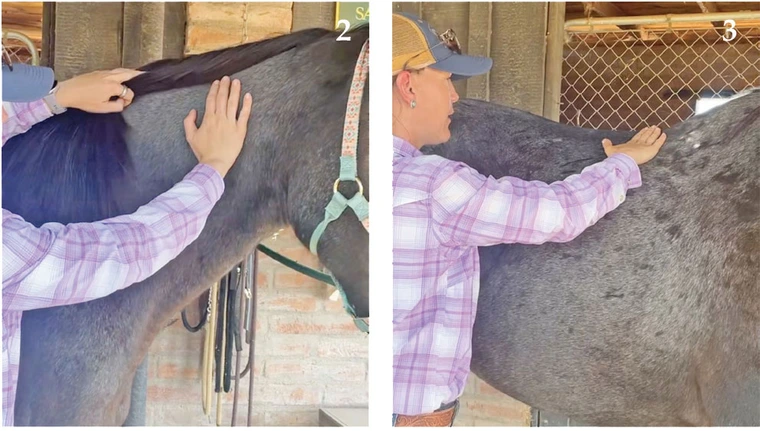
Figure 2 (left): Dr. Melchiors is feeling Roper’s muscle development along his spine. See how her hand is cupped around his C2 vertebrae region.
Figure 3 (right): In this photo Dr. Melchiors' hand is collapsed over Roper's thoracic region behind his withers.
Betsy Greene
Motion palpation and adjustments
Meat of the sandwich
Now that the chiropractor has gathered clues on the horse’s motion and joints, they may put the horse through some range of motion exercises. This is the meat of the sandwich, the good stuff! The doctor is testing joint freedom by pushing down and up to see if things move freely. A joint that is not healthy or normal will have a lack of movement when precise and gentle pressure is applied and then taken away. This could include gently tipping the head and neck, while a hand is placed over certain motion units (joints) or standing on foam bales/a stool and leaning over the pelvis and spine and pressing down.
If a lack of motion is detected, that often indicates a VSC exists and an adjustment should be performed. Most often, the chiropractor will be “scanning” the joints for restrictions, and then making an adjustment as they identify problem areas. After the adjustment, they may choose to then put that joint through a range of motion test again, to ensure the adjustment was satisfactory.
A chiropractic adjustment uses gentle and precise movements, which are the key to success. Even though a horse is quite large, a twitch of the hand or arm is often all that is needed. A very effective adjustment may not be obvious to the average person watching a chiropractic session. The misalignment is corrected via a quick, short, thrust in the plane of the joint. This is a high speed, low force, maneuver that moves the joint slightly beyond its normal physiological range of movement.
To understand the normal range of movement, think about the difference between somebody interlocking their fingers and stretching their arms away from their body. A finger pulled backwards beyond normal range (extreme over flexing of the joint) is very painful and beyond normal physiology. The chiropractic adjustment more closely conforms to the slight stretch of the joint. If correct technique is used, the ligaments are NOT adversely affected.
What is a joint plane?Each joint has a variety of ways that it can be “out”. For example, if there is a subluxation in the withers area, it could be subluxated to the right, left, or up. The chiropractor has to take that into consideration when they make the adjustment by moving with the plane of the joint to move it back into its proper location. To understand this more clearly, take a look at the skeleton (Figure 4) and notice how different each area of the spine appears. If the chiropractor is not applying pressure in the correct plane of the joint based upon the “direction” of the subluxation, it can cause the animal discomfort and not be as effective. |

Figure 4: The equine skeleton - see how the withers (right side) have a sharp angle where the lumbar spine (far left side) is more vertical in orientation.
Madelyn Melchiors
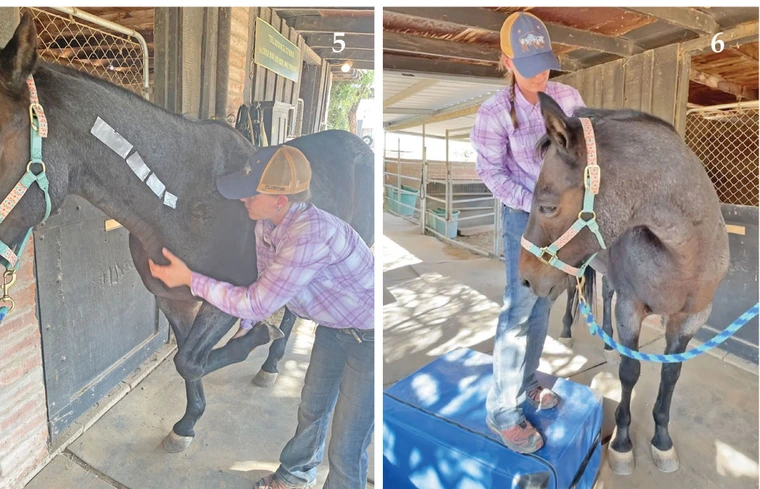
Figure 5 (left): Dr. Melchiors feeling Roper's tissues. Tape pieces represent where his cervical vertebrae are located.
Figure 6 (right): Dr. Melchiors is standing on a blue bale asking Roper to bend his neck while she motion palpates his joints.
Betsy Greene
Post Adjustment Plan
Upper slice of bread
After all joints have been assessed and properly adjusted, the chiropractor may opt to watch the horse walk and trot to visualize any changes in the horse's comfort and performance. Once the horse's response to treatment has been evaluated, some simple stretching exercises or a few days of rest may be recommended. Other times muscle strengthening and conditioning exercises may be recommended. Most performance horses during peak season will receive spinal manipulations every 4 to 8 weeks. Other horses with a more sedentary lifestyle benefit from care every 6 to 12 months.
What about Roper? - case study
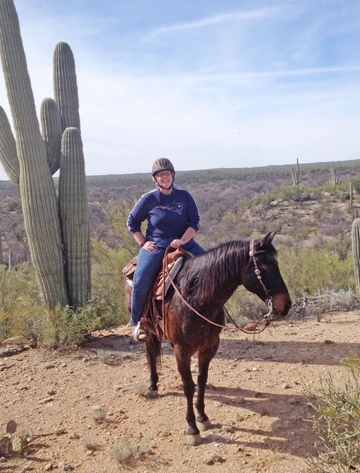
Figure 7: Roper on a ride in the desert in Tucson, Arizona.
Betsy Greene
“Roper”, 22-year-old Appendix Quarter Horse gelding, used primarily for occasional pleasure riding. Previously used as a heading horse in team roping. Located in Tucson, Arizona.
Roper’s history, first slice of bread, involved a report from his owner of occasional discomfort in the withers and pelvic area, leading to reluctance to move freely under saddle as well as bucking during warm up in the round pen. He also has an ongoing history of mild stringhalt-like symptoms. He occasionally presents with an odd behavior of backing up against hard surfaces and pushing his tail head against them. He has not been ridden in the last few months and he is either in a stall with a small pen or turned out in the arena. Roper could also be categorized as an older horse, so he is at increased susceptibility to loss of muscle strength, joint degeneration, and abnormal musculoskeletal compensations. This old guy can use some help!
Roper’s chiropractic assessment, mayo and lettuce, revealed a normal stance and mostly normal muscle development, except for a mild lack of muscle development along his T10-LS junction region, which could be due to under use and/or lack of core engagement, or a metabolic issue such as PPID. A minor injury was also observed on his back leg, which appears to be superficial. During observation at the walk, he was noted to slightly drag both hind toes. He gave the appearance of “pulling” his hind end rather than using his hindquarters to properly propel himself forward. His left hind leg swung outwards during the walk on flat ground.
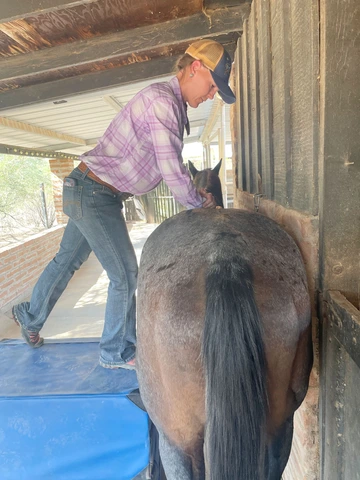
Figure 8: Dr. Melchiors standing elevated on two blue bales. This allows her to remain in the correct position and alignment as she adjusts Roper’s spine.
Betsy Greene
Chiropractic adjustments, the meat, were performed on Roper, notably in the lumbar spine, sacral apex, thoracic vertebrae in the withers area, C1 (atlas), C2 (axis), C3-C5 (base of neck), and Temporal Mandibular Joint (TMJ). The limbs were also assessed, with adjustments made to the carpal bones, glenohumeral joint, ulna, scapula, and stifle.
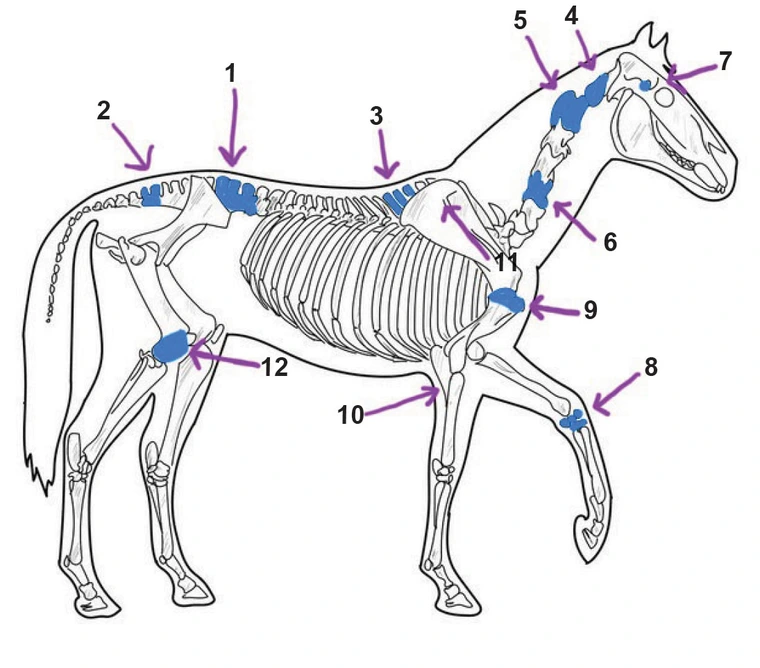
Figure 9: Areas on Roper that were adjusted. 1 - Lumbar spine, 2 - Sacral apex, 3 - Thoracic vertebrae in the withers area, 4 - C1 (atlas), 5 - C2 (axis), 6 - C3-C5 (base of neck), 7 - TMJ, 8 - carpal bones, 9 - glenohumeral joint, 10 - ulna, 11 - scapula, and 12 - stifle.
Madelyn Melchiors
After adjustment, Roper was noted to be dragging his hind toes more than pre-adjustment. This was likely occurring from him being more relaxed, as well as temporary influences on his proprioception, which can be a common, temporary, side effect following chiropractic adjustment involving the TMJ.
A post-adjustment plan, the final slice of bread, was made for his owner to perform a few targeted exercises and stretches, including pelvic tucks and carrot stretches. Diagnostics were not recommended during this visit but they did discuss the importance of monitoring Roper for any progression in signs of discomfort or difficulty in movement. If signs worsen or new symptoms develop, a further diagnostic workup should be considered.
To support Roper's recovery and overall condition, riding him hard immediately after the chiropractic adjustments was not advised. Engaging in core exercises, such as pelvic tucks and stretches, was also recommended to improve his top line and overall condition. Making Roper work for treats by performing stretches can also help engage his muscles and improve flexibility.

Figure 10: Roper is happy and relaxed after his chiropractic adjustment.
Betsy Greene
Mythbusters
Common misconceptions and questions with equine spinal manipulation include theories that:
Myth: If you do not hear a “popping” noise, the joint is not actually being modified or fixed. A popping noise during human chiropractic adjustments is called an audible. Audibles in the veterinary patient are often indicative of heavy handed adjustments that tend to be too aggressive. The limbs are the main area an audible can normally be heard in animals. Audibles while adjusting the pelvis and spine are uncommon.
Myth: Tools are necessary to adjust horses. While horses are large, it takes very little force to put motion into a joint. Chiropractic adjustments occur as high speed, low forces which are successful when performed at the perfect angle and perfect placement. Some chiropractors may choose to incorporate a tool, however a lack of hammers and mallets does not indicate a lack of accuracy or efficacy. A chiropractic adjustment should not hurt an animal if performed correctly. Mild muscle soreness can be expected, as the body is acclimating to an improved, but different, posture.
Myth: Horses need frequent adjustments for the rest of their life to benefit. Many animals improve within one chiropractic adjustment, however it may take 3 to 4 adjustment sessions for tangible benefits to be seen. Unless special circumstances exist animals should not be adjusted more frequently than every 3 to 4 weeks. If adjusted too frequently, animals may become overly sore, apprehensive, or over stimulated.
Myth: Chiropractors are straightening the spine and putting bones “back in place”. The goal of chiropractic is not to “straighten” the spine or put a bone in a physically different location. Motions including pulling legs or the tail in a firm manner to straighten is not appropriate. The spine has natural curves to help absorb shock and function properly. A chiropractor works with the body’s natural curves and physiology.
When is chiropractic not enough?
A decision many horse owners may struggle with is deciding when to pursue chiropractic care versus a veterinary lameness evaluation on their horse. Many opt to pursue chiropractic adjustments when they detect a decline in their horse's performance, a noticeable imbalance in the way their horse walks, or a sign that their horse has pain in their back and neck. If a horse's condition is subtle or seems straight forward, spinal manipulations can greatly benefit a horse. Chiropractic care can help reduce restrictions from compensating from a lameness. If a horse has a lameness that is noticeable at the walk and trot, chiropractic is not likely to cure the issue. Head bobbing lameness, hot and swollen joints, or sudden significant performance issues are considered a medical issue, not a chiropractic one.
Should a horse’s imbalances or performance worsen while receiving chiropractic treatments, veterinary diagnostics need to be pursued immediately. If a horse acts painful and reactive, multi-modal therapies are needed. Asking your veterinarian for a plan that incorporates chiropractic into your horse's performance and wellbeing is an excellent way to ensure longevity and optimal health. It is well known amongst the chiropractic community that horses who receive regular chiropractic care oftentimes require less frequent joint injections and yield long term performance benefits. It takes a team, and oftentimes a village, to keep a horse healthy and sound!
Additional resources
American Veterinary Chiropractic Association.
https://www.animalchiropractic.org/
Haussler, Kevin. 1997. Application of Chiropractic Principles and Techniques to Equine Practice. AAEP Proceedings. Vol 43:pg 312.
https://optionsforanimals.com/wp-content/uploads/2019/02/Principles-and-Techniques-to-equine-practice.pdf
Hiney, K., Greene, E.A. and Melchiors, M. 2024. Chiropractors, The story of pushing and pulling to make your horse feel great. Tack Box Talk Podcast. https://www.buzzsprout.com/242373/episodes/16127808-chiropractors-the-story-of-pushing-and-pulling-to-make-your-horse-feel-great
International Veterinary Chiropractic Association.
https://ivca.de/
Options for Animals College of Chiropractic. 2025. What is animal chiropractic?
https://optionsforanimals.com/animal-owners/what-is-animal-chiropractic/
State of Arizona House of Representatives. 2015. Arizona Revised Statutes. HB 2215, section 32-2220; relating to the practice of animal chiropractic.
https://www.azleg.gov/legtext/52leg/1r/bills/hb2215p.pdf
Vaccinating for clostridial diseases is an important part of a ranch health program. These infections can have significant economic impacts on the ranch due to animal losses. There are several diseases caused by different organisms from the genus Clostridia, and most of these are preventable with a sound vaccination program. Many of these infections can progress very rapidly; animals that were healthy yesterday are simply found dead with no observed signs of sickness. In most cases treatment is difficult or impossible, therefore we rely on vaccination to prevent infection. The most common organisms included in a 7-way or 8-way clostridial vaccine are discussed below. By understanding how these diseases occur, how quickly they can progress, and which animals are at risk you will have a chance to improve your herd health and prevent the potential economic losses that come with a clostridial disease outbreak.
The Genus Clostridium
Clostridia are a genus of gram positive rod shaped bacteria that are normally found in the soil and the digestive tract of healthy animals. Their prevalence means that even the best biosecurity program can’t prevent animals from being exposed. These bacteria often exist without causing problems until the right circumstances allow them to cause disease. They are strictly anaerobic, which means they require the absence of oxygen to survive. Clostridia are one genus of bacteria that have the unique ability to sporulate, forming microscopic endospores when conditions for growth and survival are less than ideal. Once clostridial spores reach a suitable, oxygen free, environment for growth they activate and return to their bacterial (vegetative) state. They can then begin to multiply and produce potent toxins that cause disease in most mammals (including humans). The prevalence of clostridial organisms and ability to survive even in dry, hot soil makes them a regular threat to livestock.
Blackleg (Clostridium chauvoei)
Blackleg is a typically fatal disease of cattle caused by the bacteria Clostridium chauvoei. Young animals (4 months to 2 years) that are well-fed, healthy, and growing are the mostly commonly affected and the rapid onset of the disease means treatment is usually unsuccessful. C. chauvoei are normally found in the intestines of cattle and sheep, but also persist in soils where they may be picked up by grazing animals. The spores cross from the digestive tract to the bloodstream where they are deposited in tissue throughout the body. Once they find a suitable oxygen depleted site they become active and begin causing disease which progresses rapidly. Muscle overexertion or damage that causes bruising may trigger active disease. Infected animals may exhibit signs of lameness, fever, and decreased appetite along with a characteristic gaseous swelling under the skin of large muscle groups such as the upper leg, hip, shoulder, or neck. Death usually occurs in 12 - 48 hours. Because the disease progresses so rapidly, often the only indication of an outbreak is a dead animal with significant swelling of affected muscle tissue and gas accumulation under the skin. Affected muscles will also have areas of black, necrotic tissue with a foul odor.
Malignant Edema (Clostridium septicum)
Cattle with open wounds such as cuts, abrasions, or castration sites may be vulnerable to infection by Clostridium septicum, the bacteria responsible for malignant edema. C. septicum inhabits the intestinal tract of most livestock, it is shed in feces and typically infects healthy tissue through the contamination of open wounds such as cuts or castration sites. Cows may become infected after a difficult calving that causes injury to the reproductive tract. Malignant edema infection causes local fluid accumulation (edema) and swelling near the wound, along with high fever and decreased appetite. The affected tissue in deceased animals will be darkly discolored with a necrotic odor but will not typically have the gas accumulation associated with blackleg. Treatment with penicillin is effective only if started very early in disease onset; animals that survive are often disfigured. Death typically occurs in 24-48 hours and the only signs of infection may be one or more dead animals.
Black disease (Clostridium novyi)
Feedlots are the operations most frequently affected by Black disease. It is caused by Clostridium novyi type B and likely gets its name from the characteristic darkening of the underside of the skin. The exact routes of infection are not clear but as with other clostridial organisms, it is likely that C. novyi is transmitted orally or through a contaminated wound. The spores cross the intestinal lining and take up residence in the liver. Cattle infected with liver flukes are more prone to C. novyi infection; the damage caused by the flukes creates the ideal oxygen reduced environment for the bacterial spores to germinate. The bacteria then release a toxin (α-toxin) which causes widespread edema and necrosis of the liver. As with many of the clostridial diseases, the sudden death of apparently healthy animals may be the only sign of disease.
Redwater (Clostridium haemolyticum)
Cattle that live in or near marshy, wet, lowland areas, where liver flukes are common, may also be susceptible to C. novyi type D, formerly called Clostridium haemolyticum. C. haemolyticum causes a disease known as redwater. Adult cattle tend to be more easily infected than younger animals. The organism survives in the soil and in the carcasses of infected animals. Similar to black disease, C. haemolyticum spores or vegetative bacteria enter the digestive tract, cross the intestinal lining, and settle in the liver. Liver damage (such as from liver flukes) may create the ideal conditions for germination. C. haemolyticum releases a toxin (β-toxin) which causes liver necrosis. The toxin also enters the bloodstream where it destroys red blood cells. The excess hemoglobin from these destroyed cells is released in the urine, causing it to have a red tinge (hence, redwater). Signs of infection include fever, pale mucous membranes, decreased appetite, abdominal pain, and red-tinged urine. Clinical signs can last as few as 12 hours in pregnant cows up to 3 or 4 days in other cattle. High doses of antibiotics may successfully treat the disease if administered early
Enterotoxemia (Clostridium perfringens)
Enterotoxemia in cattle and calves is typically associated with Clostridium perfringens (types A through D), although several other clostridial organisms may also cause it under the right conditions (e.g. C. septicum, C. sordellii). C. perfringens type C is a common cause of death in calves. In newborn calves, it causes necrotic enteritis. Calves develop abdominal pain, weakness, and depression along with bloody diarrhea. Symptoms appear suddenly and calves often die before showing signs of infection. Type C is a normal inhabitant of the digestive tract; infection is usually brought on by a sudden increase in milk intake (such as when calves are returned to the cows after a separation for management practices). C. perfringens Type D is often called “overeating disease”, and is common in older calves (<2 years) that are being fed a high grain ration. Again, this organism is commonly found in the digestive tract of animals and ingestion of excess feed can trigger the disease. Calves exhibit decreased appetite, weakness, diarrhea, and incoordination.
Sudden Death Syndrome (Clostridium sordellii)
C. sordellii is commonly associated with “sudden death syndrome” in feedlot cattle. Typically, there are no signs of disease or infection other than the sudden death of one or more animals. Upon necropsy, these animals exhibit necrosis and massive hemorrhage in the brisket and throat area with little or no gas accumulation. Transmission is not known, but oral transmission is suspected.
Lockjaw (Clostridium tetani)
Tetanus (more commonly known as lockjaw) is caused by the neurotoxin releasing bacteria Clostridium tetani. Like most clostridial organisms, C. tetani is found in the soil and the digestive tract of animals. It’s most commonly associated with puncture wounds, but any minor wound such as docking site, castration site, ear notch, ear tag, or injection site can be a source of entry for the bacteria. Unlike the fast acting agents of blackleg or malignant edema, C. tetani is relatively slow moving with an incubation period of 24 hours to 2 weeks. The toxins produced can either disseminate through the vascular system (descending tetanus) or travel up the axons of nerves (ascending tetanus) to reach the spinal cord. As they cross nerve synapses, they bind the terminals causing sustained spasms and rigid muscle paralysis. Signs of infection include muscle tremors, difficulty chewing and swallowing, and muscle rigidity spreading to the back and tail. Death occurs from respiratory failure in a few days to 2 weeks’ time. Treatment with antitoxin and/or antibiotics may be effective if administered early, especially if administered prophylactically (after a potential wound but before any signs appear).
The Bottom Line
The fast acting nature and prevalence of these diseases makes timely diagnosis and treatment extremely unlikely. An outbreak can have serious financial implications to the bottom line of a ranching operation. Vaccination is extremely effective and vaccinations for the bacterins and/or the toxins they produce are available in a variety of combinations, the most common being the 7-way or 8-way clostridial. Typically, the 8-way will contain the bacterin for C. haemolyticum (redwater) while the 7-way does not. Additional, C. tetani is not typically included in a 7 or 8-way, but is available on its own as either a toxoid (a long acting vaccine against the bacteria itself) or an antitoxin (passive immunity against the toxin that lasts 7-14 days). Calves that are castrated via an elastrator band should receive either 2 doses of C. tetani toxoid at least 2 weeks prior to castration, or the antitoxin at banding, or both. In addition to vaccinating for the Clostridial diseases, a well-designed ranch vaccination program should include vaccinations for other viral and bacterial disease complexes (i.e. Infectious Bovine Rhinotracheitis, Parainfluenza Type 3, Bovine Viral Diarrhea, Brucellosis, Pasteurella, Hemophilus, Bovine Respiratory Syncytial Virus, Vibriosis, and Leptospirosis). Consult with your veterinarian to develop a herd vaccination protocol that best protects your cattle and calves. Always follow all label instructions, including proper vaccination handling, administration, and withdrawal times as well as Beef Quality Assurance practices.
References
- Arnold, M. (2018). Don’t Forget Tetanus Prevention when Banding Bulls!. Ohio BEEF Cattle Letter. https://u.osu.edu/beef/2018/03/21/dont-forget-tetanus-prevention-when-banding-bulls/
- Fish, R. D., Cuneo, S. P., Glock, R., & Pater, S. (2008). Developing a Livestock Vaccination Program. Backyards & Beyond, Summer, 6–8.
- Fraser, C. M., Bergeron, J. A., Mays, A., & Aiello, S. E. (Eds.). (1991). The Merck Veterinary Manual (Seventh). Rahway, NJ: Merck & Co., Inc.
- Maas, John (University of California, D. (2012). Clostridial Vaccines: Why We Use Them. California Cattleman, 12–13.
- Mcguirk, S. M. (2015). Managing Clostridial Diseases in Cattle.University of Wisconsin, School of Veterinary Medicine.
- Powell, J. (n.d.). Livestock Health Series: Blackleg and Other Clostridial Diseases. University of Arkansas Division of Agriculture.
- Songer, J. G. (1993). Blackleg and Malignant Edema Control. In R. Gum, G. Ruyle, & R. Rice (Eds.), Arizona Ranchers’ Management Guide (pp. 15–18). Arizona Cooperative Extension.
- Songer, J. G., & Post, K. W. (2005). Veterinary Microbiology: Bacterial and Fungal Agents of Animal Disease. Elsevier Saunders.
- Wren, B. (n.d.). Clostridial Diseases. Beef Cattle Handbook. Extension Beef Cattle Resource Committee.
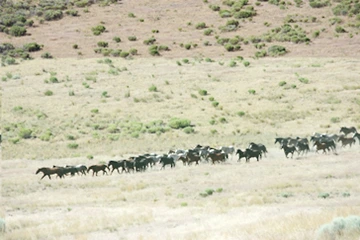
Figure 1. Wild horses in Owyhee Horse Management Area, Nevada, USA.
Betsy Greene
Few images of the West are more iconic than a herd of wild horses galloping across the landscape. The Wild Free-Roaming Horses and Burros Act of 1971 ensured these images would continue as living symbols of the historic and pioneer spirit of the West. As cultural icons of the West, wild horses hold great emotional significance, often eliciting heated debates and litigation over how these animals should be managed (Kaweck et al. 2018). The goal of protecting wild horses and burros while managing them to achieve a thriving natural ecological balance has challenged the Bureau of Land Management (BLM) and US Forest Service (USFS) Wild Horse and Burro Programs since their inception (NRC 2013). Often, the general public is not aware of the complex factors that go into managing U.S. public lands. One primary factor that is frequently misunderstood is that access to most public lands is federally mandated and includes all groups, including the public, ranchers, timber harvesters, native animals, feral horses, etc. Additionally, few understand that the BLM and USFS are required by law to manage public lands to sustain a healthy environment for multiple uses, including horses and burros. The goal of this article is to summarize key factors concerning horse and burro management on public lands to increase our understanding of the many challenges involved.
Federal Protection of Wild Horses and Burros
Wild horses and burros (WHB) are currently protected under the Wild Free-Roaming Horses and Burros Act of 1971 (WHB Act; Public Law 92–195). This Act protects unbranded or unclaimed WHB on select public lands from being captured, branded, harassed, or killed. The Act authorizes the Bureau of Land Management (BLM) and Forest Service (USFS) to provide habitat for WHB in areas where they existed on public lands in 1971. Both agencies must manage WHB at a ‘minimum feasible level’ to maintain their wild status. This means that, unlike livestock, it is difficult to control when, where, or how long WHB may graze within (or outside of) a designated management area. Additionally, because federal public lands are managed to sustain multiple uses (What are Public Lands and who are they for? - see below), the BLM and USFS are mandated to manage WHB in a way that maintains a ‘thriving and natural ecological balance’ on the landscape.
Why are Wild Horses and Burros protected?
To appropriately answer this question, a brief history of western public lands is required. After the U.S. government gained control of western lands, the lands owned by the federal government (e.g., public lands) were governed under a ‘commons’ system where individuals shared use of these lands. Over time, the commons system led to competition among multiple interests (cattle, sheep, local, and transient operators) competing with one another in a “race for feed” which resulted in poor rangeland conditions from overstocking and excessive grazing impacts known as the “tragedy of the commons” (Hardin 1968).
To limit rancher conflict and improve rangeland health, Congress passed the Taylor Grazing Act in 1934 (Public Law 73-482). This Act installed a system of grazing districts and a grazing permit system on public lands that allowed ranchers to obtain leases or permits from the government to graze their livestock based upon priority use (1929-1934), base property production, and public land carrying capacity. With ranchers now having more control over specific grazing allotments, they also had more accountability to sustainably manage land under their lease or permit. The BLM initiated an “adjudication” period in the mid-1950s to mid-1960s to survey and establish the carrying capacity of public lands being grazed under lease. This adjudication period began the determination of our public land's carrying capacity that could sustainably support livestock and wildlife. However, feral horses were not considered livestock or wildlife and became increasingly viewed as pests by land and wildlife management agencies now responsible for the sustainable management of public lands and wildlife habitat, and as competition to the ranchers' dependent upon public lands for grazing. During World War II, free-roaming domestic and feral equids were rounded up for use in the military cavalry and domestic and foreign meat markets. Following the war, feral horses were gathered and processed into commercial pet food (Sowell et al 1983). Post-World War II, feral horses and burros remaining on public lands that were not owned or claimed, were captured and removed in significant numbers through a process known as ‘mustanging’ (Godfrey and Lawson 1986) which involved hunting and/or capturing feral horses and burros, using airplanes, trucks, pit traps, and poisoned water holes.
By the 1950s, feral populations had decreased significantly, and the capture methods employed by mustangers impelled Velma B. Johnston of Reno, Nevada, later known as "Wild Horse Annie," to protect these animals. She organized a letter-writing campaign, known as the “Pencil War,” to bring attention to the inhumane methods implemented to gather feral horses and burros (Burkhardt 2024). In response, Congress passed the Wild Horse Annie Act (Public Law 86- 234) to ban the use of motorized vehicles and the poisoning of water sources to hunt, capture, or kill feral horses and burros on public lands. However, this act did not include Wild Horse Annie’s recommendation that Congress initiate a program to protect, manage, and control feral horse and burro populations. Public interest and concern continued to gain momentum until Congress eventually passed the WHB Act in 1971. Ironically, Mrs. Johnston later expressed how she may have unintentionally “started something that has gotten out of control” and condemned many of the advocacy groups and provisions in the WHB Act. She believed that unmanaged WHB populations would lead to inhumane suffering and death of her beloved WHBs from starvation and thirst (Burkhardt 2024).
Are Wild Horses and Burros “native” to the United States?
This is a tricky question because horses and burros are part of the Equidae family which arose in North America about 4 million years ago. However, likely due to a combination of climate change and hunting, all equid species became extinct on the continent during the last Ice Age roughly 12,000 years ago (Grayson 2007). For several thousand years, between the Ice Age and the European discovery of North America, horses were absent from the continent until Christopher Columbus brought domesticated horses with him on his second voyage in 1493 (Cortés et al. 2016). Soon after, Spanish conquistadors brought more horses and burros to Mexico and what is now the southwestern U.S. Over time, domestic horses and burros escaped, or were intentionally let loose, and feral populations became well-established (Wild, native, free-roaming, or feral - see below). Between the 1600s and early 1900s feral horses and burros were abundant across much of the West. With the onset of the Industrial Revolution in the late 1800s, horses and burros, once integral to modern civilization, became less needed for transportation, agriculture, and other needs. Consequently, more unneeded horses were released into the wild.
Where are Wild Horses and Burros located?
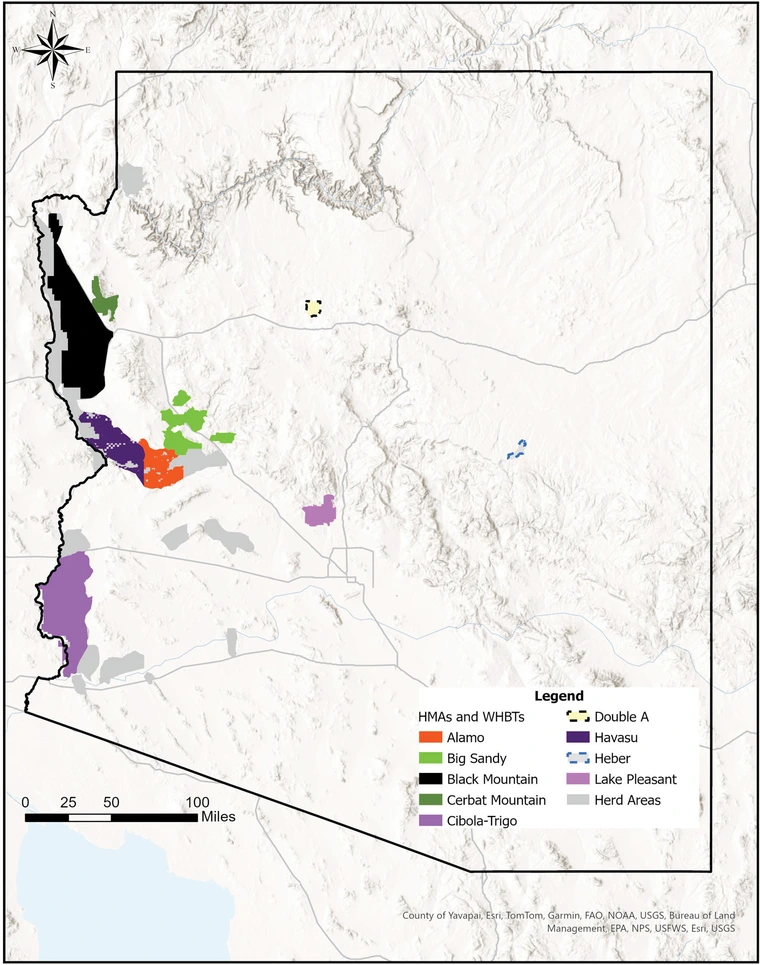
Figure 2. Location of Bureau of Land Management Herd Management Areas (solid colors) and US Forest Service Wild Horse and Burro Territories (dashed lines) within Arizona. Map also includes BLM Herd Areas (grey polygons), which are areas where WHB may exist but are not managed for as part of the multiple-use concept.
County of Yavapai, Esri, TomTom, Garmin, FAO, NOAA, USGS Bureau of Land Management, EPA, NPS, USFWS, Esri, USGS
Locations where WHB existed on public lands when the WHB Act was passed in 1971 are known as Herd Areas. However, Herd Areas are not currently managed for WHB populations as part of the multiple-use concept. Areas where WHB must be explicitly managed according to the 1971 WHB Act are known as Herd Management Areas (HMA) on BLM lands and Wild Horse and Burro Territories (WHBT) on USFS lands. Currently, there are 177 HMAs spread across 10 states with a total acreage of 31.6 million acres (BLM 2024). The USFS manages 53 Wild Horse and Burro Territories in 9 states, but only 34 of these currently have WHB populations (USFS 2014).
In Arizona, the BLM manages 7 HMAs while the USFS has jurisdiction over 2 WHBTs (Fig. 2). Arizona is home to the largest population of burros of any state (BLM 2024) where 5 of the 7 Arizona HMAs are solely managed for burros (Table 1). The USFS territories are the Heber (Apache National Forest) and Double A (Kaibab National Forest). The Heber is managed for horses while the Double A is managed for burros.
How many Wild Horses and Burros are there?
WHB populations quickly rebounded after the passage of the WHB Act in 1971, so much so that the act was further amended by the Public Rangelands Improvement Act (PRIA) of 1978 (Public Law 95–514). This act was established to improve rangeland conditions, but it was also implemented to manage the high cost of administering the WHB Act. This legislation recognizes that overpopulated WHB ‘pose a threat to their own habitat, fish, wildlife, recreation, water and soil conservation, domestic livestock grazing, and other rangeland values.’ This Act requires the BLM and USFS to determine appropriate management levels (AML) within horse and burro management areas. AML is a population size range of WHB set to achieve healthy WHB herds while simultaneously allowing sufficient forage for livestock and wild animals. Currently, WHB numbers exceed AML in every state except Idaho (Table 2). Across most states population sizes are 2-5 times the maximum AML (Table 2). Nationally, the maximum AML is 26,785 (BLM 2024), but national population size estimates are nearing 59,000 horses and over 14,000 burros, or approximately 275% of the maximum AML (Table 2). The current Arizona population sizes of WHB on BLM land are about 366% of the maximum AML. Recent estimates of populations are not currently available for WHB on USFS lands.
Ecological issues with overabundant Wild Horses and Burros
All rangelands have a carrying capacity, which is the average number of wildlife and/or livestock that may be supported within a management unit compatible with the management objectives for the unit (Bedell and SRM, 1998). When there are too many hooves on the ground in the same general location for too long of a time, regardless of species, damage to vegetation communities and related rangeland resources can occur. For example, feral horses and domestic cattle are both implicated in degrading riparian areas. However, horses may have a greater impact on riparian areas than cattle because horses often have year-round access to these areas, while cattle are generally removed for part of the year and oftentimes during growing seasons (Kaweck et al. 2018). Wild horses and burros differ from livestock and wildlife in a few other key ways that make them more likely to negatively impact natural resources.
Cattle, sheep, and most native ungulates (hooved mammals including deer, elk, bighorn sheep, and pronghorn) are ruminants (Janis 1976). This means they have a 4-chambered stomach containing a fermentation chamber where bacteria break down forage into energy for the animal. This chamber is located before the small intestines, which helps a ruminant obtain as much energy from their forage as possible (Fig. 3). Horses and burros are ungulates but are not ruminants; instead, they are considered hindgut fermenters because their fermentation chamber, called a cecum, lies after the small intestine (Fig. 3). This means that WHBs are less efficient in obtaining energy from their forage than a ruminant (Janis 1976). Hindgut fermenters are also less efficient in water retention (Janis 1976). These two factors mean that a WHB must eat and drink more to sustain themselves than a comparatively sized cow or elk. Second, WHB possess upper and lower incisors while ruminants only have lower incisors and an upper dental pad (Fig. 4; Scasta 2014). This allows WHB to clip vegetation closer to the ground than livestock and native ungulates. Thus, WHB grazing methods can limit the regrowth of vegetation because the growth points (i.e., meristems) of grasses occur close to the ground.
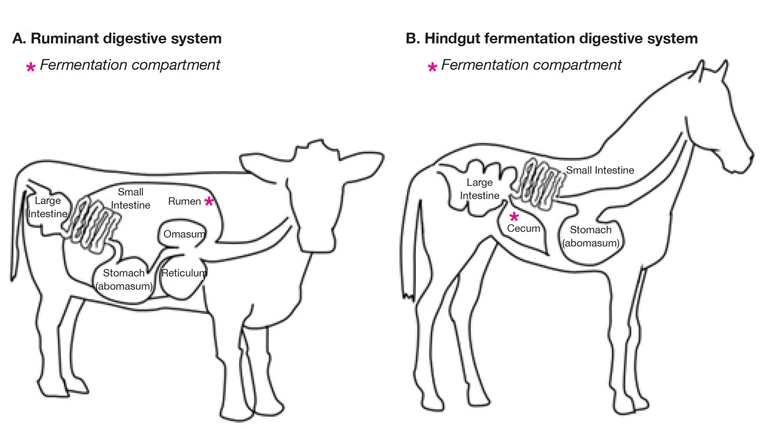
Figure 3. Comparison of digestive systems between a ruminant (cow), and hindgut fermenter (horse). Note that the main fermentation chamber of the cow (rumen) is located before small intestines, while the fermentation chamber of the horse (cecum) lies after the small intestines.
Figure adapted from Scasta (2014)
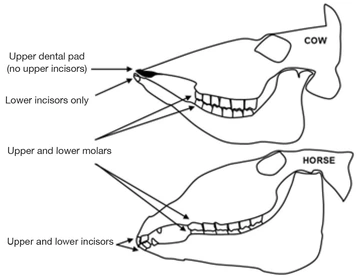
Figure 4. Comparison of dental morphology between a ruminant (cow), and a horse. Note that ruminants do not possess upper incisors, instead they have an upper dental pad.
Figure adapted from Scasta (2014)
A wide body of research shows that when the grazing impacts of WHB are not properly managed they adversely impact western rangelands. For instance, areas in the Great Basin that were exposed to unmanaged horse grazing had lower forage quantity, plant heights, and native plant diversity than similar sites where horses were removed or excluded (Beever et al. 2003, 2008, Davies et al. 2014, Boyd et al. 2017). Additionally, overgrazing by horses may lead to an increase in invasive species, more exposed bare soil, and increased soil compaction (Ostermann-Kelm et al. 2009, King et al. 2019, Hennig et al. 2021). These effects combine to increase erosion rates, degrade rangeland quality, and reduce carrying capacity.
In addition to their effects on vegetation and soil, WHB can also affect the animals they share the land with, especially at watering sites. Water is a precious resource in semi-arid western rangelands, and horses have been shown to actively exclude wild and domestic ungulates from watering holes (Perry et al. 2015). In California, bighorn sheep avoided preferred watering sites when horses were nearby (Ostermann-Kelm et al. 2008). Pronghorn in Nevada spent more time being vigilant and less time eating or drinking near water sources when horses were present (Gooch et al. 2017). In Utah, both pronghorn and mule deer altered which watering sites they used and when they visited them to limit interaction with horses (Hall et al. 2018). Also in Utah, the presence of horses at watering sites resulted in less native plant diversity compared to water holes where horses were excluded (Hall et al. 2016). A recent study showed that in HMAs where horse numbers were consistently above AML, the population sizes of greater sage-grouse declined over time compared to sites that were within AML (Coates et al. 2021).
How are population sizes obtained?
Accurate estimates of WHB are crucial to the management of these animals and their habitat. Ideally, a census would count every animal that occupies an area. However, conducting a true census of any wild animal population is extremely challenging across large, rugged landscapes, such as our Arizona rangelands. Currently, the BLM and USFS use aerial surveys to estimate the number of WHBs present with HMAs. Perfect detection of WHB (or any other animal species) is rarely accomplished; thus, agencies implement survey methods used to estimate the number of animals missed. The main method that the BLM uses is the Simultaneous Double-Observer method (Lubow and Ransom 2016). This method involves flying an aircraft, typically a helicopter, along transects laid out across the management area. Observers within the aircraft independently detect WHB groups and record variables known to influence detection probability. The data are statistically analyzed to generate a population estimate. However, this method often underestimates the true population sizes of WHB, particularly burros (Hennig et al. 2022). Recently, researchers have been working on methods to provide more accurate estimates of WHB (Hennig et al. 2022, Hennig and Schoenecker 2023).
What does the federal government do when there are too many horses and burros?
When survey data indicate that an HMA is above its maximum AML and damage is being caused to the range, the BLM and USFS will conduct a gather to remove ‘excess’ animals (Greene et al. 2011a, Greene et al. 2011b, Heleski et al. 2011). Gathers are typically performed by private, commercial contractors using helicopters to drive animals into temporary traps. Another method used to gather horses and burros is bait-trapping, which involves luring animals into holding pens with food or water. In Arizona, bait trapping is the preferred method of catching animals due to lower costs and the lack of access to equipment needed for helicopter gathers. After the animals are gathered, the agency transports the removed animals to short-term BLM holding facilities where they are assessed by a veterinarian, receive vaccinations, and prepared for placement into private care through an adoption program. Animals that are not adopted are offered as sale animals (not for commercial purposes) or placed in contracted off-range pastures. The BLM contracts with private landowners, primarily in the midwestern U.S., to have these animals graze on their lands until the end of their natural life.
Fertility control is another method federal agencies implement for controlling WHB population sizes, but it is not yet an effective method for long-term control. Currently, 3 fertility control vaccines are federally approved for use in WHB populations. The most effective vaccine can prevent pregnancy for up to 4 years, but only if the female receives a second dose 1-2 years following the first (Bechert et al. 2022). This can be hard to accomplish since WHB either need to be gathered, treated, and released, or staff must find WHB on the range and administer the vaccine with dart guns. Finding WHB in remote, rugged, and vast rangelands is difficult in the first place, not to mention that staff must get close enough (~30 yards) to the often-wary animals for the dart to penetrate the hide (Gedir et al. 2021). Fertility control measures can successfully slow population growth, but a large proportion of females within a herd need to be vaccinated to reduce or at least maintain population growth (Garrott 1991). Some have suggested that the best use of fertility control on WHB populations would be for the BLM to remove enough individuals to get within AML in each HMA, and then administer fertility control to the remaining individuals (Garrott and Oli 2013). Ongoing research is underway to find more effective fertility control methods (BLM 2024).
If the federal government is mandated to control Wild Horse and Burro populations, why are they overabundant?
Wild Horse and Burros have high reproductive rates which, combined with few natural predators, can cause populations to grow by 15-20% annually (NRC 2013). In other words, if the BLM conducts a removal gather, they usually must perform another gather every 3-5 years just to keep the population within AML. The keyword in the previous sentence is “if.” The WHB Act contains conflicting language stating the animals should be protected and only managed minimally; but it also states that the BLM and USFS should remove excess animals. This has led to the BLM being sued for both managing the animals too much and not enough, with both sides prevailing (Scasta et al. 2018). Furthermore, the National Environmental Protection Act (NEPA) of 1969 (Public Law 91-190) mandates that any federal management action is subject to public comment which can slow down or even stop removal gathers.
When the BLM is permitted to remove animals, the cost of doing so is expensive. In 2023, removal gathers cost the BLM $5 million to remove 5,335 animals. Keep in mind that this was only 10% of the total number of excess animals (BLM 2024). A significant impediment for the BLM to remove all excess animals is the high cost of caring for the animals they have previously removed but could not adopt or sell. Currently, approximately 62,000 horses are living in off-range holding pastures – 23,000 in short-term corrals and 39,000 in long-term, private pastures. The BLM pays the owners of these pastures to provide for the horses. Last year, the BLM Wild Horse and Burro Program spent $108 million, or 69% of its yearly budget, on off-range animals. In 2013, a study projected that by the year 2030, the BLM will have spent $1 billion on off-range horses (Garrott and Oli 2013). Currently, the agency is on track to surpass that number (Fig. 5). The off-range pastures are near capacity (BLM 2024), so unless adoption rates dramatically increase or the BLM can contract with more private landowners, their ability to remove excess on-range animals is limited.
The cost of horse and burro management on USFS lands is a different economic issue. The WHB Act did not allocate money to the BLM or USFS to manage the animals they are responsible for managing. Eventually, the BLM’s Wild Horse and Burro Program was created and receives annual funding to manage the animals (CRS 2022). In contrast, the USFS does not receive annual funding specific to managing WHB. This means that to perform any management activities, the USFS must take money from other programs or ask for monetary help from the BLM (National Wild Horse and Burro Advisory Board 2024).
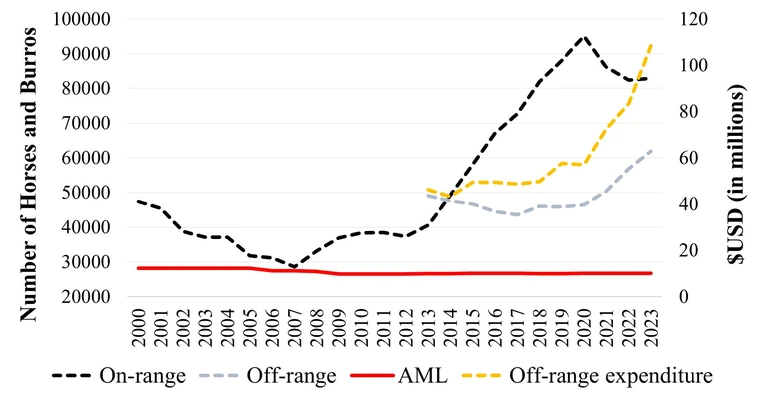
Figure 5. Number of wild horses and burros on BLM lands (on-range), number of horses and burros in off-range care, the national maximum appropriate management level (AML), and annual off-range expenditures by the BLM since the year 2000.
Figure adapted from Hennig et al. (2023)
Comparing the management of Wild Horse and Burros to livestock and native wildlife
The issues with WHB management in the United States are more challenging compared to managing livestock and wild ungulates. Livestock grazing permits on federal land are largely administered by the BLM and USFS (BLM 2020). To ensure long-term rangeland health, livestock grazing is managed by regulating livestock numbers (i.e., animal units), along with timing, duration, and intensity of use (BLM 1997). Accordingly, federal grazing permits for livestock place allotment-specific restrictions on season(s) and duration of use, number of animals, and type of livestock allowed within the permitted area or allotment. BLM and USFS staff monitor rangeland conditions and adjust grazing management decisions in response to the combined impacts of grazing by domestic and wild ungulates, fire, drought, and market conditions (BLM 2020). Conversely, WHB grazing is not managed for timing, duration, or intensity, nor is AML adjusted in response to rangeland conditions.
Unlike WHB, wild native ungulate populations are managed by individual states in accordance with the North American Wildlife Conservation Model (Mahoney 2004). This model states that wild vertebrates are reserved for the noncommercial use of individuals and are to be managed in a way that promotes sustained populations (Mahoney 2004). State wildlife agencies administer hunts to optimize population levels. These agencies use information from previous hunt statistics, sportsmen's comments, and results of habitat monitoring to implement hunting protocols (NDOW 2024). Like livestock grazing, protocols are put in place to manage the timing, intensity, and duration of hunting pressure to achieve population goals (NDOW 2024). Also, like livestock grazing, state agencies generate revenue for management actions by selling hunting licenses and harvest tags (Mahoney 2004). Lastly, both livestock and wild ungulate management is routinely informed through research projects (e.g. Sawyer et al. 2012, Northrup et al. 2016). Comparatively, there is little understanding of WHB ecology, and existing research has had minimal impact on WHB management (Hennig et al. 2018, 2023).
Summary
Both the BLM and USFS are mandated to manage public lands for multiple use and sustained yield of natural resources, and to balance all of these uses so that no one use degrades the ability of another. On select BLM and USFS lands, WHB populations and habitat are considered just one of many multiple uses. The multiple-use concept aims to have public lands utilized in a combination that will best meet the present and future needs of the American people. The portrayal of wild horses as the essence of America’s Wild West heritage, from old John Wayne movies to present-day social media avenues, can be somewhat myopic or tunnel-visioned relative to the extensive and complicated aspects of land and animal management. In the 1950s, when Velma “Wild Horse Annie” Johnston urged the passing of federal legislation, her goal was to ensure the humane treatment of WHB and keep these living cultural representations of the West alive on public lands. Successive legislative protections for WHB populations have required the BLM and USFS to manage these animals to maintain not only the health of horses, but also the native plants and animals.
As we have discussed in this article, high WHB reproduction, limited predation, extensive management costs, and limited options for dealing with excess WHB have resulted in serious, unintended ecological and economic consequences. When compared to livestock ruminants, WHB have no grazing restrictions and a different digestive morphophysiology. Thus, WHB can have greater negative impacts on our rangeland and riparian resources, e.g., decreased forage quality and plant diversity, longer vegetation recovery times, impacted soils, and altered foraging behavior of domestic and wild ungulates. When WHB populations exceed AML, federal agencies may conduct removal gathers that are expensive and time consuming. The BLM WHB program spent $108 million in 2023 on removed animals and is projected to exceed $1 billion cumulatively by 2030 to care for animals in off-range pastures. Moreover, there is little space to house and feed unadopted animals because the off-range pastures are near capacity.
The policy and management of WHB is a complex and emotional issue. Nonetheless, there need to be legislative changes to offer more options for managers to care for these animals and the land they occupy. The unintended ecological and economic consequences from the WHB Act may lead to irreversibly degraded habitat which will result in inhumane suffering and death of these Western icons. Ironically, this is what Velma “Wild Horse Annie” Johnston was advocating to prevent.
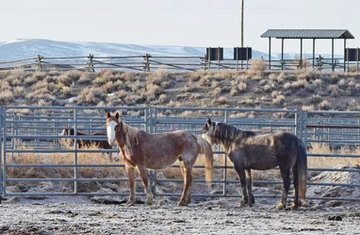
Figure 6. Wild horses in a Wyoming, USA, temporary holding facility.
Jacob Hennig
References
See PDF file
School gardens provide great teaching opportunities, while also encouraging healthy lifestyle choices. With sustainable school gardens growing more popular statewide, interest in serving garden grown produce in the school cafeteria is increasing. This article will help schools navigate the system for certifying their school garden and follow Standard Operating Procedures currently recommended.
Introduction
Ionophores are a class of antibiotics labeled for use in cattle, small ruminant, and poultry feed to slow the growth of intestinal coccidia and improve feed efficiency. While antibiotics fed to animals that are considered important for human health are now regulated under the Veterinary Feed Directive (VFD), and require the equivalent of a prescription from a veterinarian; ionophores are not used in humans and therefore, are not included under this rule. They may be purchased “over the counter” from any feed supplier. Commonly used products (and some brand names) include monensin (Coban, Rumensin), lasalocid (Bovatec), and salinomycin (Biocox, Saccox). Ionophores are absorbed in the digestive tract and when toxic amounts are ingested, the heart, skeletal muscle, and also the kidney and liver can be negatively affected. Horses are very susceptible to ionophore toxicity; the lethal dose is less than 1/10th of the amount that can be safely fed to cattle. For monensin, 2-3 mg/kg, or about 1 gram, is enough to poison a 1,000 lb. horse. For salinomycin, that amount decreases to 0.6mg/kg. Even a very small amount of an ionophore is enough to kill your horse.
Signs of Ionophore Toxicity
Severity and speed of onset of clinical signs depends on how much they ingest. Horses with a common feed source can be affected simultaneously.
- Sudden death
- Exercise intolerance
- Feed refusal
- Colic
- Increased heart/respiratory distress
- Hypotensive shock.
Note: If the horse survives, it will likely have some level of permanent damage to heart muscle, possibly leading to poor performance and congestive heart failure.
Is My Horse at Risk?
Horses are usually exposed to ionophores by gaining access to medicated feed intended for cattle or poultry. This could be by unknowingly purchasing a product containing ionophores which is not intended for horses, or allowing ranch horses to eat with the cattle. Be sure to read all feed labels carefully. If ionophores are being fed to other animals on the property, take precautions to ensure horses cannot gain access to the feed or are not accidentally fed the medicated feed. Even exposure to poultry waste containing ionophores can cause issues with horses.
On occasion, mistakes in mixing or cleaning protocols at feed mills have happened, resulting in distribution of horse feed tainted with ionophores. These occurrences are rare, and reputable feed mills have protocols in place, which may even include separate equipment or facilities, to ensure this does not happen. The U.S. Food and Drug Administration introduced specific rules in 2011 to establish CGMP’s (Current Good Manufacturing Practices) and preventative controls for animal feed manufacturers. These animal feed regulations should decrease potential of feed mill errors.
Treatment
There is not a specific drug to reverse ionophore poisoning, but supportive care may help, depending on severity. This includes emptying the gastrointestinal tract by treating with mineral oil and activated charcoal, and using IV fluids to support heart output. Serious cases may require extensive nursing care including heart monitoring and antiarrhythmic drugs.
Prevention
Ionophore toxicity is a result of ingestion of the compound. Therefore, do not allow your horse to have any access to feed prepared for use in cattle, small ruminants, or poultry. Read feed bag labels carefully, if any ionophores have been added, the product and amount will be on the label. Do not buy or use “damaged” bagged feeds that don’t have a label. These feeds may be discounted, but the cost may end up being your horse’s life. If the toxicity is the result of errors from the feed manufacturer, there may be extensive legal implications for that company.
You should always maintain good records of feed provided to your horse, including labels and lot numbers. This will be valuable information in the case of a recall or suspected poisoning. Simply tearing off the entire label (including the lot number), marking it with the date you opened the bag, and placing it in your filing cabinet is one easy way to keep track of this information.
Cattle Feed Label Examples
Note that the drug monensin has been clearly marked on the labels below. These labels also include a “Caution” statement against feeding this feed to horses, however not all ionophore feed labels carry this warning. These example feed labels are courtesy of the University of Arizona Feedlot and Brice Tabor.
References and Further Reading
- Buckeye Nutrition. (2017 July). Deady Consequences: Is Your Horse Feed Safe? Horsemen’s Corral. Retrieved from http://pubs.royle.com/article/Deadly+Consequences%3A+Is+Your+Horse+Feed+Safe%3F/2818971/419613/article.html
- Gioja, J. (2006 November). Toxicology Brief: “Ionophore Toxicosis in Horses”. Vet Folio. Retrieved From http://www.vetfolio.com/toxicology/toxicology-brief-ionophore-toxicosis-in-horses
- House, A. M. (n.d.). Monensin and Lasalocid Toxicity in Horses. University of Florida College of Veterinary Medicine and Institute of Food and Agricultural Sciences Extension. Retrieved from http://nwdistrict.ifas.ufl.edu/phag/files/2015/02/Monensin-and-Lasalocid-Toxicity-in-Horses.pdf
- Ionophore Intoxication in Horses. (2012, March 21). The Horse. Retrieved from http://www.thehorse.com/articles/28868/ionophore-intoxication-in-horses
- Raia, P. (2015, April 1). Is My Horse’s Feed Safe? The Horse. Retrieved from http://www.thehorse.com/articles/35570/is-my-horses-feed-safe
- Wright, A., Faulkner, D., & Cuneo, P. (June 2016). Veterinary Feed Directive Changes for Arizona Livestock Producers.
- University of Arizona Cooperative Extension Publication. Az1705. Retrieved from https://extension.arizona.edu/sites/extension.arizona.edu/files/pubs/az1705-2016.pdf
Introduction
Artificial Insemination (AI) is an advanced reproductive technology with several potential benefits to a cow-calf producer’s profitability. Arizona producers who implement AI on their operation may increase calf crop value by creating more uniformity and introducing high-quality genetics into their herd. However, there are also factors and costs related to cattle management, facilities, labor, and marketing that producers should consider when deciding to implement AI.
Making the Decision
- What is my end goal with Artificial Insemination?
▪ Why do I want to implement AI in my operation, and what are my objectives? - What costs are associated with starting AI?
▪ Consider all potential costs, including equipment, labor, and veterinary services. - Can I capture added value on the calf to recoup the added cost per cow?
▪ What’s my marketing strategy to ensure AI adds value to my operation? - Do I have a specific number of cattle required to reach the “break-even” point?
▪ Is AI economically feasible for a small herd, or do I need to scale up? - Do I need to learn AI techniques, or can I hire a professional?
▪ What are the costs and benefits of each option, and which is more suitable for my operation? - How much time and effort will AI require?
▪ Consider the time needed for heat detection, AI procedures, and overall cow management. Are my current practices compatible with these demands? - How fast and significantly can AI improve my herd’s genetics?
▪ What are my genetic goals, and how does AI fit into my breeding plan?
Making AI Work for You
- Maintain an optimal Body Condition Score (BCS) for breeding cows.
▪ Ensure cows have a BCS of at least 5 out of 9 to maximize the chances of a viable pregnancy. - Provide adequate nutrition throughout pregnancy and lactation.
▪ Secure enough feed resources to maintain cow health and support calf development, increasing the likelihood of successful rebreeding. - Develop and follow a comprehensive herd health, nutrition, and management plan.
▪ Do I have appropriate vaccinations needed for pregnant animals to prevent abortive losses. Do I have good herd surveillance for infectious disease? - Ensure facilities are safe and stress-free for both cattle and handlers.
▪ Set up your facilities to minimize stress during AI procedures, which can improve success rates. - Do I have animals that are able to be bred and if not have I had them checked to make sure they are able to conceive?
▪ Are your heifers of breeding age? Do I have a veterinarian check for pregnancy, breeding soundness, and other reproductive issues?
There are two major benefits to AI: bringing in and capitalizing on genetics that might otherwise not be available to a producer and unifying a calf crop to increase value.
Improving Genetics
Purchasing Bulls
Purchasing top-quality bulls can be a costly (and risky) endeavor. Good bulls with high-quality genetics routinely top sales and may be out of reach for some producers or impractical for Arizona’s range conditions. With an average bull ratio of 15:1 (Teegerstrom & Tronstad, 2016), compared to the national average of 25-35:1 (APHIS, 2009), Arizona ranches face higher bull costs due to the expansive landscapes typical of the region. Each bull on an operation comes with additional costs beyond just his purchase price: proper bull management including yearly breeding soundness exams and trichomoniasis testing is crucial in any cattle operation to ensure bulls are sound and fertile. Bulls can be extra hard on fences and equipment, and they may wander on to neighboring ranches risking exposure to diseases like trichomoniasis, which can render them unsuitable for breeding. Purchasing quality bulls from out of state further exacerbates these challenges. Bulls that are accustomed to higher-quality grazing and more temperate climates often struggle to adapt to Arizona's harsher range conditions. The combination of lower quality forage, extreme heat, and the physical demands of covering vast terrain can lead to significant declines in their performance and overall health. As a result, these naïve bulls may rapidly deteriorate when expected to work under these challenging circumstances, making them less effective in breeding operations.
Purchasing Genetics
While purchasing live bulls can be costly and competitive, especially when selecting from a limited pool of available animals, artificial insemination offers a more affordable and flexible alternative. With semen straws priced between $20 - $60 on average, AI allows you to choose from thousands of bulls, selecting the genetics that best fit your operation without the limitations of local availability or the risk of a high-value bull deteriorating under Arizona's harsh rangeland conditions. Instead of investing in a few bulls at a higher purchase price ($3,000-$6,000), you can optimize your herd's genetic potential with AI, avoiding the challenges of acclimating a live bull to the local environment, reducing the biosecurity risk of introducing new animals, and reducing the overall cost per cow.
Expected Progeny Differences
Another significant advantage of AI is the ability to select bulls based on Expected Progeny Differences (EPDs), a tool that estimates the future performance of a bull’s offspring compared to the breed average. Purchased bulls seldom come with EPD data, whereas bulls marketed for AI require EPD data to be listed. Expected Progeny Differences are available for various traits, such as calving ease, birth weight, weaning weight, rib eye area, and marbling; this provides a lot more data and can help make better decisions about how his offspring will perform. Additionally, most breed organizations offer EPD indexes that combine multiple traits into a single score, helping producers identify bulls that excel in specific areas like carcass quality, growth, efficiency, or maternal traits. While EPDs have some limitations— such as lower accuracy in bulls with fewer offspring and limited application in crossbred cattle—recent advances in genomics are enhancing their utility, especially in crossbred operations. These advancements provide producers with even more precise information, allowing for well-informed decisions when selecting the best genetics for their herds. You can also purchase extra straws of a bull's semen and store them for later use, especially if you find certain characteristics in your herd that you'd like to preserve. Semen can be stored indefinitely, provided that the liquid nitrogen tank is properly maintained.
Increased Calf Crop Value
Uniform Calf Crop
There are benefits to AI beyond just improving the genetics of your herd. A successful AI program will include estrus synchronization, where a specific sequence of hormones is administered to bring all the cattle into heat within a short, predictable time frame. In addition to allowing you to AI all the cows within a set time frame of your choosing, synchronization protocols offer two key advantages: a condensed calving season and a more uniform calf crop. A shorter calving season not only increases the value of your calves by producing a heavier, more uniform group but also enables you to better monitor calving for potential issues. With calves being born within a more concentrated time frame, you can position them closer to the ranch for easier observation and management, reducing the time and resources needed to ensure a successful calving season. Research from the University of Tennessee demonstrated an additional 20% of calves could be born in the first 30 days of the breeding season utilizing AI (Griffith et al., 2020). This could translate to an additional 20-44 lbs. of weaned calf just from using an estrus synchronization protocol ("Costs of Siring Calves: Artificial Insemination Compared to Natural Service," 2018). Cows that are inseminated on the same day will calve within 2-3 weeks, with the majority born within a 10-day period. Calves will also be more uniform in color and growth, as you can achieve consistent genetics across your herd by using semen from a select few AI bulls, rather than relying on multiple live bulls for natural breeding.
Genetic Improvement
The use of AI also allows the mating of specific cows or groups of cows to specific bulls. The entire herd doesn’t have to be artificially inseminated. Some examples of choosing AI for specific subsets of the herd include breeding first calf heifers to a bull proven to have low birth weights, producing future replacement heifers with specific genetics, or increasing carcass characteristics in the calf crop. You could even choose to use AI on your entire herd and then use cleanup bulls for those that are open. For registered herds, AI is often heavily utilized to obtain the desired genetics. Some producers may choose AI one year and then opt for a bull the following year. There are numerous management strategies available that can be tailored to meet the objectives of your operation.
Marketing
Marketing should be a consideration in the decision to implement AI into your operation. Artificial Insemination should be viewed as an investment in your operation. The producers who are operating successful beef businesses recognize the importance of capturing a premium when investing in the operation. Because you have an increased investment of time and money into each cow you AI, you need to consider how to capture that cost within your operation. It may be as discussed, in the form of quality replacement heifers or a more uniform calf crop, which will hopefully translate into more calves on the ground and more pounds on the hoof. While utilizing some form of advanced marketing (i.e. selling on the grid, direct marketing) makes it easier to capitalize on the benefits of AI, it is still possible to see improved profitability on the value of your calves no matter how you choose to market.
Time
The time required for AI varies depending on the chosen synchronization protocol. Estrus synchronization protocols range from 5 days to 10-14 days, with cattle needing to be worked from 1-4 times during that period (not including the insemination process itself). Some protocols are timed AI, where all animals are insemination on a fixed time schedule regardless of whether they are showing signs of heat. Heat detection protocols require frequent checking of animals over a 1-2 day period to identify those showing signs of estrus and inseminating them approximately 12 hours after signs of heat are observed. Additionally, successful AI should be followed by pregnancy checking, ideally 32-40 days after breeding. This step is crucial as it allows producers to identify open animals promptly and rebreed them to avoid any loss of time. Knowing exactly when the animal was bred and when to check for pregnancy not only helps in managing the breeding schedule but also provides valuable feedback on the effectiveness of the AI techniques used.
Return on Investment
Using the Bull vs AI Breeding Cost Excel Spreadsheet from Kansas State University (Pendell & Johnson, 2015) and Arizona specific cost estimates (Teegerstrom & Tronstad, 2016), the estimated cost per head for AI is approximately $61/cow. Together, with the cost for the clean-up bulls (approximately $46/cow) this equals $107 total cost per cow exposed, or $126/calf, assuming an 85% pregnancy rate. In contrast, the average cost per cow of all-natural service is approximately $110, with the same assumptions about pregnancy rate and a 20:1 cow-to-bull ratio. In this scenario, an additional $16 in value is needed per calf to break even on the cost of implementing AI. A study conducted by the University of Tennessee comparing the cost of timed AI vs natural service estimated a similar amount: from approximately $10-$26 additional cost for an AI pregnancy, depending on bull purchase price and herd size (Griffith et al., 2020). This value could be capitalized on by weaning heavier calves and marketing calves with superior genetics for carcass characteristics. Of course, every operation has different costs for bull maintenance, labor, and may choose semen at a higher or lower price point.
To make the best decision if AI is right for your ranch, it’s essential to compare these costs against those of natural service. For a detailed and personalized cost comparison, check out the Bull vs AI Breeding Cost Excel Spreadsheet from Kansas State University. This tool allows you to input your own operational estimates and assess the cost of AI versus natural service on a per-pregnancy basis, helping you determine the most cost-effective breeding strategy for your operation.
| Item | Cost | Details |
Initial Supplies
| ~$400 | Includes semen thawer, AI gun, basic disposables (sheaths, lube, etc.). Pre-assembled kits are available. |
| Semen Storage Tank | $800-$2000 | Cost varies with size. |
| Semen Tank Maintenance (approx. yearly) | $100-$200 | Tanks require re-filling with liquid nitrogen and should be checked monthly to ensure they do not run dry |
| Synchronization Hormones | ~$25-$35 per cow | Cost depends on the chosen protocol. |
| Semen | $20-$60 per straw | Specialty genetics may cost more. |
| Facility Alterations and Labor | Variable | Costs depend on specific operation and need for additional labor or hiring an AI technician |
Challenges to implementing AI
Artificial insemination is not ideal for a year-round breeding operation or one that doesn’t check cows for pregnancy every year to ensure they are open before the estrus synchronization process is started. A year-round breeding schedule unnecessarily complicates the AI process, as not all the cows you want to breed will be predictably open at the same time. Administering hormones to a bred cow may result in the loss of the fetus she is carrying. If you do leave your bulls out year-round, you will want to transition to a defined breeding season before attempting to implement AI.
Veterinary Involvement
A relationship with a veterinarian is also crucial, as the hormones used in estrus synchronization are available by prescription only (though they can be administered by the producer). These synthetic hormone products must be handled with care and adequate personal protective equipment, as they can be absorbed through the skin and interact with the human endocrine system (Wright, 2023). The importance of establishing a veterinary client-patient relationship (VCPR) cannot be overstated. Your veterinarian is an important resource for pregnancy detection and breeding soundness exams, and can advise you on a vaccination protocol, nutrition, and recommend the best estrus synchronization protocol for your herd.
Technician
A trained AI technician is crucial because the AI process must be executed correctly at every step. The success rate for well-trained AI technicians in cattle can vary, but research indicates a success rate of around 60-70% (Perry et al., 2011). To ensure that cows not successfully bred via AI still produce a calf, you will need to use clean-up bulls. While AI won’t eliminate the need for bulls in your operation, it can reduce the number you need, allowing you to maintain a smaller bull battery. Although the average producer can learn to AI their own cows, attention to detail is essential. The AI process involves many potential pitfalls, including mishandling of semen, deviations from estrus synchronization protocols, improper straw thawing or preparation, and incorrect deposition of semen. All of these factors can lead to a lower success rate. For those interested in learning AI, attending an AI clinic or school is highly recommended. A good understanding of anatomy and palpation experience is crucial. Not knowing how to safely perform AI can lead to perforations in the reproductive tract, resulting in peritonitis and the animal's inability to be bred. Causing trauma to the reproductive tract can induce bleeding, and since blood is toxic to sperm, this may result in reduced conception rates, permanently infertile animals, or animal death. Begin with a small group of cows and refine your technique until you achieve a satisfactory success rate before expanding your AI program to a larger portion of your herd.
Facilities
Access to facilities poses a significant challenge for many producers in Arizona. During a one-week to ten-day period, cows must go through a chute 2-4 times for synchronization protocols and the AI process itself, depending on the chosen estrus synchronization protocol. Well-designed facilities and calm, easy-to-handle cattle make the AI process smoother and increase the likelihood of successful pregnancies compared to handling stressed cattle.
Health and Nutrition
Finally, AI cannot overcome significant management issues including inadequate vaccination protocols, Bovine Viral Diarrhea Virus (BVDV) or Trichomoniasis in the herd, or a poor nutrition plan as body condition score is highly correlated with pregnancy rate (Carvalho et al., 2022). If, however, your ranch has a good handle on herd health, a sound nutrition and mineral program, and is looking for a way to invest in genetics and improve the value of the calf crop, AI might be a consideration.
References
Services: Centers for Epidemiology and Animal Health Retrieved from https://www.aphis.usda.gov/animal_ health/nahms/beefcowcalf/downloads/beef0708/ Beef0708_is_BullMgmt_1.pdf
Carvalho, R. S., Cooke, R. F., Cappellozza, B. I., Peres, R. F. G., Pohler, K. G., & Vasconcelos, J. L. M. (2022). Influence of body condition score and it schange after parturition on pregnancy rates to fixed-timed artificial insemination in Bos indicus beef cows. Animal Reproduction Science, 243.
Costs of Siring Calves: Artificial Insemination Compared to Natural Service. (2018). https://www.beefresearch.ca/blog/costs-of-siring-calves-artificial-insemination-compared-to-natural-service
Griffith, A. P., Boyer, C. N., Rhinehart, J. D., & Carter, C. (2020). Cost-Benefit Analysis of Timed A.I. and Natural Service in Beef Cattle (University of Tennessee Department of Agriculture and Resource Economics Extension Reports, Issue W 899).
osPendell, D., & Johnson, S. (2015). KSU-Bull vs AI Breeding Costs. Retrieved 12/15/2023, from https://www.agmanager.info/ksu-bull-vs-ai-breeding-cts
Perry, G. A., Dalton, J. C., & Geary, T. W. (2011). Management Factors Influencing Fertility in Beef Cattle Breeding Programs. Applied Reproductive Strategies in Beef Cattle, Joplin, MO.
Teegerstrom, T., & Tronstad, R. (2016). Arizona Ranching Budgets: 2016. (az1734). https://extension.arizona.edu/sites/extension.arizona.edu/files/pubs/az1734-2017.pdf
Wright, A. D. (2023). A Guide to the Hormones Used in Cattle Ustrus Synchronization for Artificial Insemination. https://extension.arizona.edu/pubs/guide-hormones-used-cattle-estrus-synchronization-artificial-insemination
Introduction
The cattle industry faces significant threats from foreign animal diseases. It is estimated that a foot-and-mouth disease outbreak in the United States could result in $221 billion in economic losses (NCBA, 2024).
On May 9, 2024, the United States Department of Agriculture (USDA) Animal and Plant Health Inspection Service (APHIS) published an amendment to the current Animal Disease Traceability (ADT) rule in the Federal Register (https://www.ecfr.gov/current/title-9/chapter-I/subchapter-C/part-86) electronically AND visually for certain cattle and bison transported across state lines or tribal boundaries. The new ADT rule will take effect on November 5, 2024.
Animals affected by the new ADT rule
The following animals are subject to the new ADT rule:
- All sexually intact cattle and bison 18 months of age or older.
- Note: This rule currently excludes most feeder cattle.
- All dairy cattle of any age.
- All cattle and bison of any age used for rodeo, exhibition, or recreational events.
Animals tagged before November 5, 2024, with the previously approved visual-only tags do not need to be re-tagged with an Electronic identification ear tag (EID). These visual-only tags will remain the official identification for the animal's lifetime. Brands are not considered official individual identification in the state of Arizona nor most other brand states for the purposes of interstate movement. Brands primarily establish ownership in compliance with state law.
What is animal disease traceability?
Animal Disease Traceability (ADT) is crucial for ensuring a rapid response to animal disease outbreaks. An efficient and accurate ADT system helps identify where diseased and at-risk animals are, where they have been, and when they were there. This reduces the number of animals involved and exposed in a disease investigation and decreases the time needed to respond. Reducing the number of animal owners affected by a disease event lessens the economic impact on producers and the industry while helping to maintain commerce (APHIS, 2024).
Many producers are already familiar with visual tags under the 2013 rule. However, the 2024 amendment requires producers to use electronic tags instead. Currently, the only approved device that satisfies the requirements for both electronic and visual identification is the “840” EID button tag. EID tags will be available at no cost to producers through their State Veterinarian’s Offices (https://agriculture.az.gov/animals/state-veterinarians-office).
Is ADT information confidential?
The new regulation requiring electronically and visually readable EID tags upholds and builds on existing USDA disease programs, which have always maintained confidentiality. There are provisions in the law to protect confidential producer data held by the USDA. Personal information is exempt from the Freedom of Information Act (FOIA) and will not be released (APHIS, 2024). Additionally, the tags are not geographic positioning devices (GPS) and do not track or transmit any environmental conditions nor store any information whatsoever. These EID tags are simply a unique number that can be read electronically instead of recording a 15-digit number by hand.
Transportation of livestock on Tribal Lands
As sovereign nations, tribes may choose to establish their own animal identification systems separate from the state. If tribal lands overlap state boundaries, livestock may move within tribal land without an EID tag. For example, the Navajo Nation occupies land in Arizona, New Mexico, and Utah. Livestock can move within the boundaries of the Navajo Nation and across state lines within these bounds, but if livestock are moved outside this area, and into a different state, the amended rule and approved EID tags would apply to those animals. To say it another way, if animals are moved off tribal land for sale, slaughter, to a livestock market, or for any other reason, animal health entry and identification requirements of the destination state must be met.
For more information
For additional information or questions about the amended ADT rule, please contact your local Extension Agent or the Arizona State Veterinarian’s Office. More detailed information can also be found in the USDA APHIS Animal Disease Traceability Rule FAQ. https://www.aphis.usda.gov/sites/default/files/traceability-faq.pdf
References
National Cattlemen’s Beef Association. 2024. NCBA Statement on USDA Final Traceability Rule. https:// www.ncba.org/ncba-news/news-releases/news/details/37749/ncba-statement-on-usda-final-traceabilityrule
United States Department of Agriculture (USDA) Animal and Plant Health Inspection Service (APHIS). 2024. Frequently Asked Questions: Animal Traceability Rule. https://www.aphis.usda.gov/sites/default/files/traceability-faq.pdf
The modern cultivated tomato originated from wild relatives in the mountainous regions of South America. It was in pre-Columbian Mexico that the tomato was domesticated before being taken to Spain as an ornamental plant. It wasn’t initially grown as a vegetable because it was believed to be poisonous. Tomatoes were adopted as a food crop first in Southern Europe, and later (19th century) in Northern Europe and the US1. Tomatoes are a popular and welcome addition to any home garden, and one of the easiest vegetables to grow. They require a little more skill in the low desert of Arizona, due to hot temperatures in summer and occasional freezes in winter. This desert region allows two short growing seasons, which means double the opportunity for delicious tomatoes.
Choose the Right Tomato Variety
There are many kinds of tomatoes to choose from, each with characteristics for specific growing environments. when choosing a variety, it is important to identify the characteristics that will make tomatoes successful in the low desert. Taking a moment to go over some important terms will make it easier to understand how to choose the right tomato.
Types of tomatoes can be referred to as cultivar or variety, but these terms mean different things.
Cultivar, or cultivated variety, is a plant that has distinctive characteristics, due to propagation practices, such as cutting or hybridizing selected plants.16 These are often propagated for specific characteristics, such as growing well in containers, low acidity, or shelf-stability. Many tomato cultivars available to home gardeners are hybrids.
Hybrid – Can be created by a breeder crossing two different parent plants together to get desired characteristics. This also occurs in nature during cross-pollination, eventually leading to new species. hybrids will offer characteristics, such as disease/pest resistance, container-friendly, well-suited to greenhouse/high tunnel, and high yield. Hybrid will be noted on front of seed packet.
Variety is the natural development of a species without the aid of humans. Tomatoes that have been grown over time in a specific geographical area are varieties that are well-suited to that location.
Heirloom is an open pollenated (by wind and insects) variety that has been grown and shared for many years in a specific place before commercial hybrids were developed beginning in the 1950s. Heirlooms are often known for great flavor, but sometimes lack resistance to disease. Plants grown from saved heirloom seed will produce the same tomato when isolated from other tomatoes.
GMO seeds have been developed with certain characteristics in mind but have not been available to the home gardener until recently. In January 2024, the first GMO tomato variety was made available to home gardeners. The Purple Tomato is the first ever GMO vegetable seed available for purchase to home gardeners. Historically, GMO seeds have been exclusively available to large scale commercial growers who are under contract agreements with the developing seed company. These seed companies do not supply their product to home gardeners or to garden supply stores.7
There are two different growth habits of tomato plants for the home gardener to choose from: indeterminate and determinate. Growth habit, days to harvest, and yield differentiate these tomato varieties.2
Indeterminate tomatoes grow and produce fruit all season. This extended harvest is heavier, but slower to mature than determinate varieties. If space is unlimited, indeterminate tomatoes are a good option to provide fresh fruit throughout the season. Indeterminate tomatoes can become sprawling plants, so are best supported by cages or stakes. Determinate tomatoes are more compact plants that grow to a certain height before flowering and setting fruit that ripens nearly at once. This is a good option for gardeners who want to preserve the fruit. Determinate tomatoes are an excellent choice for gardeners that have limited space. These plants can be grown in containers on patios, or in small garden spaces with support.
Look for terms, such as, heat tolerant, early, cherry, grape, and plum. These terms will be listed on websites/catalogs and on the packaging. Time to maturity or harvest is a very important piece of information listed on the front and/or back of the seed packet. This will be stated as the number of days from transplanting or days to maturity. This number tells you the minimum amount of time required for fruit to be produced. Early maturity dates (45 to 70 days) are the best suited to the two short growing seasons in the low desert of Arizona. Before selecting tomato (or any vegetable) varieties for the home garden, consider these things:
▪ Climate: choose arid friendly varieties
▪ Intended use: fresh, drying, canning
▪ Desired amount of fruit
▪ Garden space: container, raised bed, in – ground
▪ Starting from seed or purchasing seedlings
▪ Determinate or indeterminate
Larger fruiting, long season tomato varieties are often unsuccessful in the lower elevations of Arizona because of the shorter growing season, hot temperatures, and dry conditions. Cherry and plum tomato varieties that grow quickly (45 - 80 days) can be very productive. If the gardener wants to try a new variety, we recommend doing so alongside a known variety to enjoy a guaranteed harvest. Gardeners can choose between heirloom or hybrid varieties, each having their own benefits.
Disease resistance is another characteristic that will be listed on the seed packet. Diseases will be present depending on the specific region of the country. Letters on the seed packet and seedling label will indicate resistance to specific diseases. These indications could be as follows: V (Verticillium wilt), T (tobacco mosaic virus), F (Fusarium wilt), L (Septoria leaf spot), or N (nematodes). Listed below is an example tomato seedling tag with important information designated. Similar information will be included on seed packets.
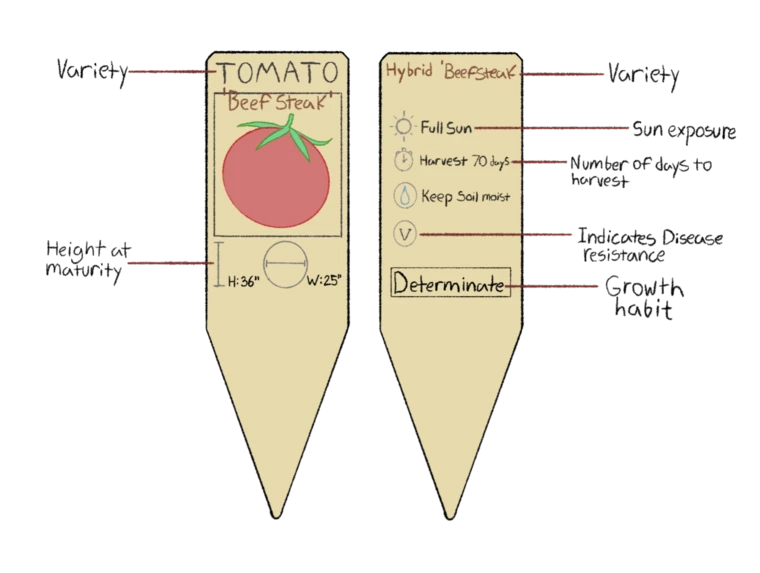
Nutritional Benefits of Tomatoes
rease fresh fruit availability as well as the availability of important nutrients in your diet. Tomatoes are rich in folate, potassium, and are a good source of antioxidants, including vitamin C and beta carotenoids, specifically lycopene.3 Folate is an important nutrient to have throughout the lifecycle for the creation of genetic material and to aid in healthy cell division.4 Potassium is important in the proper functioning of muscles and organs, including the heart and kidneys.5 Lycopene has been associated with decreased risk of some cancers including prostate, lung, uterine and breast cancer and lowered blood pressure, among other health benefits.6 Tomatoes do not need to be eaten raw to retain their nutrients; cooked and canned tomatoes remain high in nutrient content and offer even more bioavailability (the body’s ability to absorb nutrients) of lycopene.7
Storing Tomatoes
Tomatoes are best stored outside of the refrigerator when they will be eaten fresh, to preserve the taste and texture. Store in an open container or on a countertop in a cool place out of direct sunlight. They can be frozen for later use, with or without blanching, in a tightly sealed container. Though tomatoes are safe to eat from the freezer for many years, their quality will degrade in eight months to one year. If canning tomatoes or tomato sauce products, use up to date recipes from reputable sources, such as United States Department of Agriculture (USDA). Current guidelines require adding citric acid or bottled lemon juice to tomato products before canning, but the amount of acid may increase, so make sure to use an up-to-date recipe or call your local Cooperative Extension office.
How Many Tomato Plants?
Just eight plants, two per person, will supply a family of four with fresh tomatoes all season. If planning to preserve fruit for the winter, increase the number of plants to 16, or four plants per person.
Starting Plants from Seed
Starting tomatoes from seed offers some advantages. There are more choices in the cultivars available than purchasing potted seedlings. The cost is much lower, especially if using saved, traded, or gifted seeds. Using recycled food safe containers can also reduce seed starting costs.
Affordable Pot Options:
▪ Recycled: milk cartons, yogurt cups, water bottles, saved and sterilized garden center pots
▪ Disposable: toilet paper tubes, homemade newspaper pots, soil blocks
▪ Purchased: seed trays and pots (reuse and clean these next season)
When choosing a growing medium for planting seeds, keep in mind that potting soil and compost can be too dense and rich for seeds to germinate, and can slow growth. Using garden soil risks the introduction of diseases or pests to new seedlings. Instead, use a good quality, purchased seed starting mix that has been pre-moistened.
Purchased seedling mixes can be very dry, and it may be difficult for the material to absorb water. Rather than risk seeds floating out of the container along with added water at the time of planting, add moisture at least a day ahead of planting. To do this, simply add the seedling mix to a container, such as a bucket, and gradually add water while mixing by hand. The mixture should be wet, but not soggy. Cover the container until the next day, at which time, the water should be adequately absorbed.
Optional: A less expensive option is to make a seed starting mix using the directions as follows:8
Basic Seed Starting Mix Recipe | |
Coco coir* | 1 part |
Perlite | 1 part |
Vermiculite | 1 part |
*We don’t recommend sphagnum peat moss as it isn’t a sustainable product. | |
Make ½” holes with a small dibber or blunt pencil and sow two seeds in each hole. Cover seeds with soil and put in a warm location (no less than 60°F at night) with a minimum of 12 hours of balanced sunlight each day. Grow lights ensure consistent light for growing robust seedlings.
Optional: Grow light systems can be expensive, so consider using basic fluorescent (T8) lights. This is the simplest and most affordable way to start healthy seedlings at home. “Shop lights” with two T-8 bulbs can be suspended at a close distance above seedlings.8
Keep seeds moist, but not wet. Seeds will germinate within 7 to 10 days. Cover newly planted seeds with a humidity dome or clear plastic to keep soil from drying out between watering. Make sure to remove cover as soon as seedlings emerge to avoid dampening off. Although not necessary, a heat mat is a good choice for fast and even germination. Soil temperatures between 70-75°F are best for germination.
Once seedlings emerge, ensure they have adequate light to avoid leggy plants. Choose the more robust of the two seedlings in each pot, pinching out the weaker one. Once the seedlings are at least two inches and have at least three true leaves, they will benefit from some added nutritional support. An excellent choice is a dilution of fish fertilizer or seaweed extract. Another option is to water with a fertilizer solution made of one teaspoon houseplant food in one gallon of water, or use a balanced fertilizer at half strength.
Seedlings will be ready to transplant outside in 6 to 8 weeks, when 6” tall.
Remember To Harden Off Seedlings
Seedlings have developed indoors, protected from direct sun, temperature differences, and wind. An important step before transplanting outside is to “harden off” the seedlings. Hardening off is a process of gradually exposing seedlings to these outdoor elements to prepare them for the transition and avoid the risk of transplant shock or injury. A week before transplanting outdoors, place seedlings in a sheltered location for a few hours each day. Over the course of the week, increase exposure time and the amount of direct sun.
Choosing a Healthy Garden Center Plant
Choose a good quality plant that is at least six inches tall with full leaves of a rich, green color, starting low on a strong stem. Flower buds can be present, but not yet open, and new growth visible at the tips. Nurseries sell smaller plants in 6 or 8 cell packs, as well as larger single plants. The single plants are older, and more established, at a higher price. Smaller plants can be purchased and up potted at home in a sheltered location for a head start (3 or 4 weeks) until the weather warms for planting outside.
Plants that are leggy, root bound (roots visible through pot bottom), or have discoloration (indicating nutrient deficiency) should be avoided. Check for insect damage and infestation before taking them home, so as not to import pests into the home garden. Also check the label for the variety fruit size as smaller sized tomatoes do better here and check to see the maturation time and ensure you will have time to enjoy your fruit!
When To Plant Tomatoes in Southern Arizona
Tomatoes thrive in temperatures between 50°F and 90°F. Springtime in Southern Arizona, between mid-March and late June is the main growing period for tomatoes. A shorter second growing period occurs in autumn between September, when cooler weather arrives in the region, until late November, when the first frost can kill the plants. Be sure to check the local average temperatures to gauge the growing season or call your local Master Gardener program.
Spring Planting
Get an early start on your tomatoes by planting seeds indoors or in a greenhouse in January, six weeks before the last frost. This option gives the home gardener access to a greater selection of varieties.
When planting out 6-inch seedling pots, start in mid-March in Southern Arizona as soon as frost damage has ended. Some retail nurseries may not offer plants mature enough to go outside in early March.
Tomato plants need overnight temperatures to be above 55°F to set fruit. Blooms will begin to form and develop once evening temperatures warm.
Choose short-season varieties (less than 70 days). Seed catalogs will list time to maturity, or days to harvest on the seed packet.
Spring Planting
Poor fruit development during the heat of summer in southern Arizona (July – August) is expected. Temperatures above 90°F reduces the number of pollen grains in each tomato flower, which reduces pollen viability and fruit formation.18 Gardeners will get a second chance for healthy tomatoes in September, when summer heat has passed. There are three options for fall plants:
▪ In August, cut back spring plants that have become straggly to get new growth and a second crop on the old plants.
▪ Take cuttings of spring plants 3 weeks before desired fall planting time, put in water on a sunny windowsill. Roots will develop within 14 days and be ready to harden off and plant by 3 weeks.
▪ Start new seeds for September planting in June or purchase seedlings at a local garden center.
Start With Healthy Soil
Starting with healthy soil is crucial for a successful garden. A soil test is an effective way to understand the needs of your gardening site as you are beginning a new plot, repeating every three years to verify good soil health. Soil tests are easy and affordable. A list of testing facilities can be obtained from the University of Arizona Cooperative Extension office. Keep in mind that home soil tests are not as accurate as lab testing. An affordable, basic soil test will usually include nitrate-nitrogen, phosphorus, potassium, calcium, magnesium, and sodium, as well as pH, and EC (electrical conductivity).15
Healthy soil is essential for establishing strong tomato seedlings. Good soil preparation will assist in the growth of deep-root systems, which the plant needs for adequate water and nutrition throughout the season. Encourage rapid growth by preparing the soil in February ahead of planting your seedlings. Soil fertility should be moderately high, but not out of balance with too much nitrogen, which can burn delicate roots and slow plant growth. Amending with too much nitrogen reduces fruit production and makes for lush leaf growth. Generally, a plant well-fertilized early in its life will not need to be fertilized after the first fruit is set.
At planting, water each seedling with one pint of an ammonium phosphate solution (1 tablespoon ammonium phosphate per gallon of water). Phosphorus is crucial for fueling chemical reactions during the plant’s lifecycle. When adding phosphorus to crop plants, it should be applied at the root zone, where it will be most available to the plant for uptake.
Choosing The Right Site
Select a warm, sheltered part of the garden for tomato seedlings; planting in a location that is too hot, with no relief from direct summer sun will make your plants more susceptible to curly top and sunburn. The vector for curly top is the leaf hopper. These pests thrive in direct sun more often than shade, as well as areas with bare ground. Providing adequate mulch and covering with a shade cloth of 40-60% can discourage leafhoppers and prevent sunburn. Skip pruning tomatoes in the low desert; leaves provide necessary shade for the fruits. Close planting allows the plants to shade themselves.
Plant Spacing
If planting in ground, space rows about 2’ apart, and plants 18” to 24” apart in the row.
Plant Shelter and Support
Tomato cages can be used for support and shelter. Clear plastic can be attached to the cage in the cool, early days of the season, for a greenhouse effect, until the weather warms. This plastic can be removed, leaving the cage for support to the growing plant. A cardboard box can supply an inexpensive shelter from cold temperatures also.
Row Covers can be used to protect plants from seasonal frosts and to get an early start in the spring or extend the season in the fall. A floating row cover is often referred to as a frost blanket or a frost cloth. A row cover is called “floating” because it can either lay right on top of plants or put on a frame above the plants. It is made of a lightweight fabric available in several weights that can raise the temperature underneath it by 2° – 10° F higher than the ambient temperature. Once it is installed, it does not need to be removed until risk of frost has passed; water, air, and light are able to penetrate the material.
Option: An old sheet can be used for short-term frost protection, however, it isn’t as permeable as a purchased frost cloth, so should be removed periodically for proper ventilation, moisture, and sun exposure.
Providing good support is an important strategy for disease control. Keep the leaves and fruit off the ground but allow the plant to bush out. A good support can be made by encircling the plant with a cylinder of construction wire 3’ or 4’ tall and 2’ or 3’ across. The branches grow through and are supported by the 6” squares. Purchased supports such as tomato cages or stakes are also effective. Shade cloth can be draped over the frame to give shade and discourage leaf hopper infestations.
Planting Out in the Garden
After choosing the site and performing an initial soil test, follow the recommendations given in the test report. If amendments are necessary, work them into the top 6” of soil. If adding compost, apply 2” to 3” of well-composted organic matter per 100 square feet a month before planting, working it into the top layer of garden soil. These improvements will ensure the soil has good water-holding capacity, nutrient density, drainage, and aeration. Building and maintaining rich, healthy soil is crucial for growing healthy, productive plants.
Optional: A small amount of worm castings can be added to the bottom of every planting hole. Worm castings are a microbially-active amendment that can give plants a boost, improve soil structure, and increase moisture retention13. Worm castings can be purchased or obtained from a worm compost bin.
Deep planting (up to the first set of true leaves) or side planting will allow for greater root development and more robust plants. (Figure 1).
Tomatoes can be grown in containers, such as five-gallon buckets or grow bags. This gives some seasonal flexibility by allowing containers to be moved into shade in hot summer months and to a more sheltered area in winter. (Figure 2).
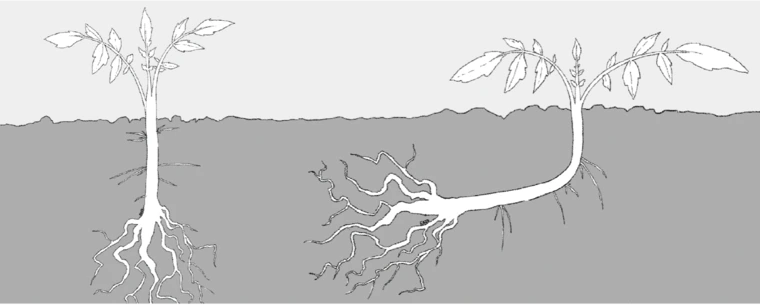
Figure 1: Illustration of deep and side planting. By Evan Adams.
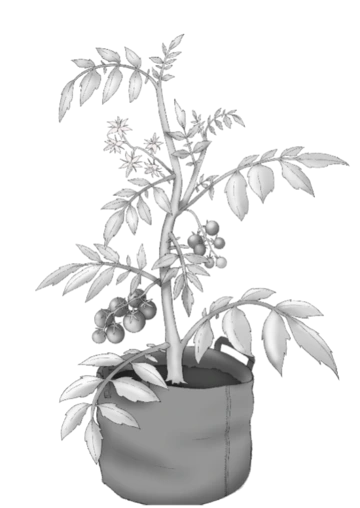
Figure 2: Illustration of tomatoes in a grow bag. By Evan Adams.
Irrigation
atering every 3 or 4 days is better than daily light watering. The frequency of irrigation should depend on soil type; sandy soils dry out rapidly and need near daily water, while clay soils hold moisture for up to a week. Keep soil at the base of plants moist, but not wet. Using a soil probe or digging down 6 inches to the root zone to check moisture is a good way to assess water needs.
Tomato roots are likely eighteen inches below the soil surface. Longer irrigation times will allow water to penetrate to this depth, encourage deeper root development, and wash away salt accumulation that may have occurred.
In summer, a good mulch around, but not touching, the base of the plant keeps the soil and roots moist and cool. Consistent soil moisture is necessary for good fruit production.
Pollinators, Intercropping, and Crop Rotation
Tomatoes have perfect flowers, which means that a tomato has a female-stigma and male-stamen on each bloom to self-pollinate. Any motion, such as wind, insects, and other vibration can shake the pollen from one part to the other within each flower. Solitary bees and bumblebees can provide this necessary vibration through "buzz" pollination; landing on the flower and vibrating it through wing beats to trigger full pollen release.
Growing two or more crops in the same row or bed is a good strategy for diversifying host plant population to reduce pest problems. Planting flowering plants that attract beneficial insects provides biological controls of pest insects.
Rotating tomatoes in the garden each season can be an effective way to prevent disease and pests. Move tomatoes to different sites if possible, or plant tomatoes in different areas of the available planting space.
Diseases and Pests
Tomatoes in Arizona are relatively free of pests and disease. However, there are a few gardeners need to be aware of. Choosing a tomato variety designated with V, F, or N after the name shows some resistance to fungal disease and nematodes.
Disease11 | Facts | Symptoms | Management |
Curly Top Image
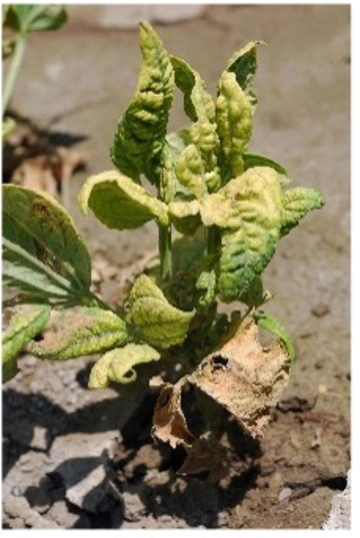
Figure 3: "Beet curly top virus geminiviridae common bean.jpg" by Howard F. Schwartz, Colorado State University, Bugwood.org is licensed under CC BY 3.0. | The beet leafhopper (BLH) insect (Figure 10) carries Beet Curly Top Virus (BCTV) and infects plants when feeding on them. Host plants include Lambs quarter, Halogeten, Russian thistle (Tumbleweed) Greasewood, and Atriplex (Four Wing Saltbush). | Young plants usually killed by infection. Older plants become yellowed and have stunted growth. Leaves become dull, thick, crispy, and roll. | Treatment: chemical control not recommended. Infected plants will not recover and should be destroyed. Weed control. Prevention: integrated pest management (IPM), row covers, and mulch (leafhoppers like to feed on plants that border bare soil areas). |
text Fusarium (Fungus) Image
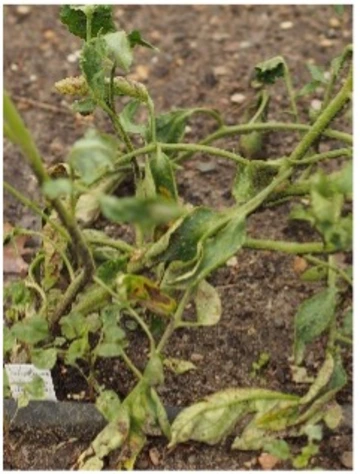
Figure 4: "Tomatoes with Fusarium Wilt 2013" by F. D. Richards is licensed under CC BY-SA 2.0. | Caused by Fusarium Soilborne fungus in warm, wet conditions that can occur in most soil types. Survives multiple years in the soil, plant residue, in soil debris on greenhouse benches, and equipment | Wilting several weeks after infection. Wilting can occur on just a portion of the host. Initially, plants may recover during the evening. permanent wilting occurs with time and high temperatures, followed by plant death. | Diagnose: remove the plant, cut a cross-section of the stem near the base of the plant. Vascular tissue will have brown discoloration. Cannot distinguish between Fusarium and Verticillium. No treatment. Infected plants should be destroyed. Do not compost. Rotate crops. Sterilize/disinfect equipment. |
Verticulum *Please note that this is extremely uncommon. It is helpful to mention it because it is pertinent to tomatoes designated with V.F.N. in their names. This fungus is what the "V” refers to. | Caused by Verticillium Fungus prefers warm, wet conditions that can occur in most soil types. Can survive several years in the soil. Infects plants through intact or damaged roots. Easily introduced to new fields by irrigation water, decayed plant material, soil particles, tools. Can be distributed in infected transplants, seeds, or tubers. | Initially, lower foliage becomes chlorotic and dies. Decreased photosynthesis reduces fruit quality. Plants wilt completely and die in severe infection. Vascular tissue will be dark and discolored. | To diagnose: remove the plant, cut the stem near the base. Vascular tissue will have brown discoloration. Cannot distinguish between Fusarium and Verticillium. No treatment. Infected plants will not recover and should be destroyed. Rotate crops to prevent fungi from building up in the soil. Sterilize pots, trays, and tools. Disinfect greenhouses. Remove and dispose of plant residues at the end of season. Do not compost. |
Pest12 | Facts | Symptoms | Management |
Nematodes Image
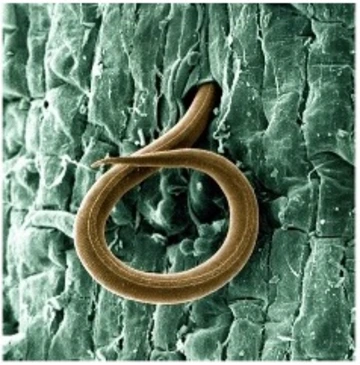
Figure 5: A larva of root-knot nematode penetrating a tomato root. Magnified 500x. Photo by William Wergin and Richard Sayre. Colorized by Stephen Ausmus. Image
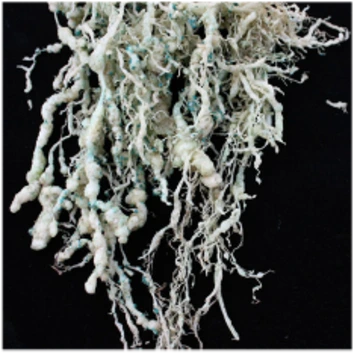
Figure 6: A tomato root infected with root-knot nematodes. Photo from Hagop Atamian, Department of Nematology, University of California-Riverside. | Microscopic roundworms are sometimes considered beneficial because they parasitize soil dwelling insect larvae that damage plants, while others are serious plant pests, such as root-knot nematode (Figure 5). Can develop from egg to adult in 21 days during warm season. A microscope is needed to visualize, so diagnosis is done by observing symptoms. | Swellings, called galls, appear on the roots of affected plants. (Figure 6). Infestations can be visualized by digging plants with symptoms and examining the roots for galls. Wilting, loss of vigor, yellowing. Symptoms appear from May to July. Leaves are sparce and small, fruits production is diminished. More symptoms see https://edis.ifas.ufl.edu/publication/NG032 Common in warm, regularly irrigated, sandy soils. | on the roots of affected plants. (Figure 6). Infestations can be visualized by digging plants with symptoms and examining the roots for galls. Wilting, loss of vigor, yellowing. Symptoms appear from May to July. Leaves are sparce and small, fruits production is diminished. More symptoms see https://edis.ifas.ufl.edu/publication/NG032 Common in warm, regularly irrigated, sandy soils. |
Caterpillars10 Image
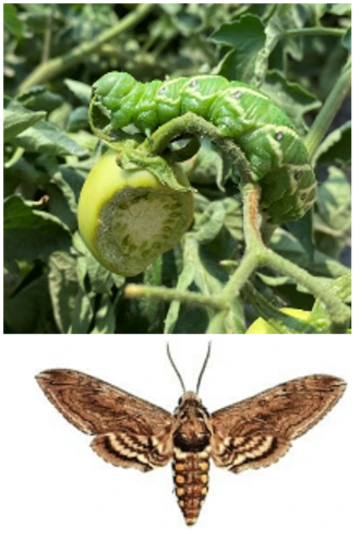
Figure 7: Larva and adult of the tomato hornworm, also known as the five-spotted hawk moth. Note the tomato hornworm has V-shaped marking on the body and a black horn. Photo from Utah State University Extension | Tomato hornworms (Figure 7) and tobacco hornworms (Figure 8). Larva of the five-spotted hawk moth and Carolina sphinx moth. Caterpillars eat leaves, stems, blossoms, and fruits of host plants. Up to 4 inches long, green with white markings, with a spine on the end of the abdomen. | Chewed leaves and defoliation, beginning from the top of the plant downward. | Monitor in early July in morning or evening. Look for chewed or missing leaves, and holes in the fruit. Dark frass (excrement) on and around the plant is visible if hornworms are present. Hand-removal is the most effective control in the home garden. Organic products such as Bacilus thuringiensis kurstaki (BTk) or spinosad work on larvae. IPM: Lady beetles and green lacewings prey on eggs. Paper wasps will feed on larvae. Braconid wasps parasitizes hornworms by laying its eggs inside hornworms |
Aphids Image
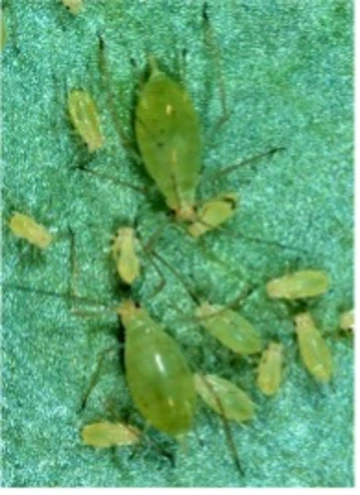
Figure 9: A group of potato aphids attacking a plant. Photo by David Voegtlin, University of Illinois. | Small, soft-bodied insects that suck sap from plant tissues on underside of leaves, such as potato aphids (Figure 9). Common during spring and summer. | Stunts plants. Produce honeydew, a sugary substance, which can cover plant surfaces. Can spread plant viruses. | Monitor plants often. IPM: lady beetles lacewings, and syrphid flies. Spray with insecticidal soap, horticultural oil, or strong sprays of water. Remove and destroy infected plants. |
Beet Leafhopper(BLH) Image
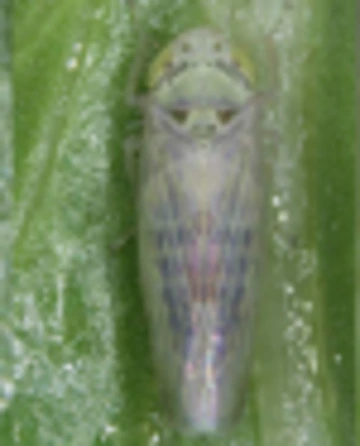
Figure 10: Adult beet leafhopper. Photo from University of Idaho Extension | Adults are 3 mm long, and wedge-shaped. Vary in color from green, grey, or tan. Jump when disturbed. Common in early summer. Multiple generations per growing season. Adults overwinter on weeds in the mustard family and migrate on spring winds. | Piercing-sucking feeding habit causes speckling on leaf surface. Direct feeding damage is not a big concern on tomatoes, but they can spread beet curly top virus, which is fatal to the plant. | Use floating row covers and shade cloth to reduce access. Monitor the field using yellow sticky cards. Control leafhoppers early when young plants are more susceptible to the virus they spread. Destroy and remove plant debris. |
Fruit | Symptoms | Management |
Image
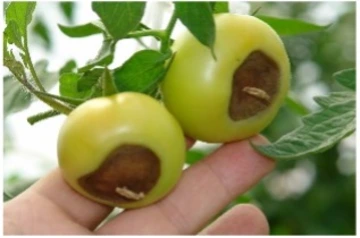
Figure 11: "DSC05447 blossom end rot calcium deficiency" by Plant pests and diseases is marked with CC0 1.0. | The flower end of fruits becomes dry and dark. Non-parasitic disease caused by calcium deficiency. Can be brought on by poor water management, drought stress, or soil imbalances. Fruits are usually affected when one-third or more grown. | Avoid inconsistent soil moisture by using infrequent, deep irrigation. Mulch to maintain soil moisture. Avoid over-fertilizing. Avoid injuring roots, do not hoe or cultivate near plant base. |
Image
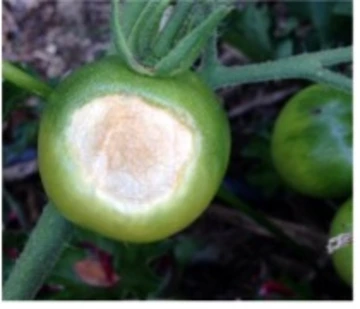
Figure12. Cannon, C., & Murray, M. (2017). Vegetable pests of Utah. Utah State University Extension | Wilting several weeks after infection. Wilting can occur on just a portion of the host. Initially, plants may recover during the evening. permanent wilting occurs with time and high temperatures, followed by plant death. | Diagnose: remove the plant, cut a cross-section of the stem near the base of the plant. Vascular tissue will have brown discoloration. Cannot distinguish between Fusarium and Verticillium. No treatment. Infected plants should be destroyed. Do not compost. Rotate crops. Sterilize/disinfect equipment. |
Image

Figure 13: “Tomato: Fruit cracks” by Plant pests and diseases is marked with CC0 1.0. | Cracks occur horizontally or vertically on the fruit. Occurs when the tomato skin is not elastic enough to handle fast growth rate. Common with alternating periods of cool, wet weather and hot, dry weather. Fast growing plants and certain varieties more susceptible. | Keep tomatoes evenly moist and do not over fertilize. Fruit is edible once the damage is removed. Smaller varieties crack less often than larger varieties. |
Image
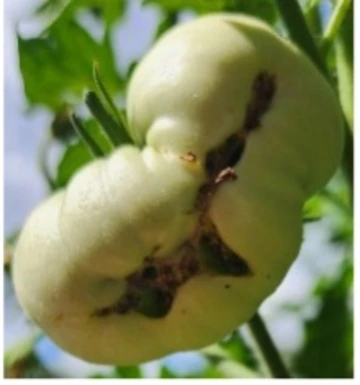
Figure 14: Tomato Cat-facing. Photo by Kara Adams. | Fruits develop a long scar at the blossom end. Associated with cold weather during early fruit set. Fruits can be misshapen, but still edible. | Protect plants from cool temperatures early in the season with cover. |
Growing Tomatoes Citations
1. Bergougnoux V. The history of tomato: from domestication to biopharming. Biotechnol Adv. 2014 Jan-Feb;32(1):170-89. doi: 10.1016/j.biotechadv.2013.11.003. Epub 2013 Nov 7. PMID: 24211472.
2. Colley, Micaela and Zystro, Jared. The Seed Garden. Chelsea Green Publishing. 2015
3. Beecher GR. Nutrient content of tomatoes and tomato products. Proc Soc Exp Biol Med. 1998 Jun;218(2):98-100. doi: 10.3181/00379727-218-44282a. PMID: 9605204.
4. Office of Dietary Supplements - Folate. Accessed August 27, 2023. https://ods.od.nih.gov/factsheets/Folate-Consumer/
5. Office of Dietary Supplements - Potassium. Accessed August 27, 2023. https://ods.od.nih.gov/factsheets/Potassium-Consumer/
6. Przybylska S. Lycopene – a bioactive carotenoid offering multiple health benefits: a review. Int J Food Sci Technol. 2020;55(1):11-32. doi:10.1111/ijfs.14260
7. Tomato-A Natural Medicine and Its Health Benefits. Accessed August 27, 2023. https://www.phytojournal.com/vol1Issue1/3.html
8. The University of Arizona Cooperative Extension. Arizona Master Gardener Manual. Arizona Legal Technologies, 2017.
9. Drost, Dan, "Tomatoes in the Garden" (2020). All Current Publications. Paper 238. https://digitalcommons.usu.edu/extension_curall/238
10. Volesky, N., & Murray, M. (2019). Tomato hornworm tobacco hornworm [Fact sheet]. Utah State University Extension.
11. Volesky, N., Murray, M., & Nischwitz, C. (2021). Vegetable diseases of Utah [Fact sheet]. Utah State University Extension.
12. Cannon, C., & Murray, M. (2017). Vegetable pests of Utah. Utah State University Extension
13. Lowenfels, Jeff, and Wayne Lewis. Teaming with microbes: The organic gardener's guide to the soil food web. Timber Press, 2010.
14. (2023). “Grow Lights for Starting Seeds Indoors.” University of Maryland Extension
15. Walworth, James Lawrence. Soil sampling and analysis. (2011)
16. Browning, Sarah J, et al. “Selecting Tomatoes for the Home Garden - University of Nebraska–Lincoln.” Institute of Agriculture and Natural Resources, Nebraska Extension Publications, 16 June 2008, extensionpublications.unl.edu/assets/html/g1864/build/g1864.htm.
17. Rayburn, Lisa. “GMO-Free Seeds.” N.C. Cooperative Extension, Onslow County Center. January 2023, https://onslow.ces.ncsu.edu/gmo-free-seeds/#:~:text=For%20gardeners%2C%….
18. Pressman, Etan et al. “The effect of heat stress on tomato pollen characteristics is associated with changes in carbohydrate concentration in the developing anthers.” Annals of botany vol. 90,5 (2002): 631-6. doi:10.1093/aob/mcf24
Rain Impacts on Hay
With the rain events we had during the last few weeks, I have received questions about rain impacts on alfalfa hay yield and quality. Alfalfa must be dried or cured for safe storage as hay, and generally we do not have problems reaching this dryness in Arizona. Normally, field and harvesting losses of hay are as high as 20 to 30% due to cutting and curing. Rain can increase these yield losses and reduce quality. The event of rain that occurs between the time forage is cut and baled extends curing time. Consequently, yield and quality are decreased, reducing the value of the crop as an animal feed and marketable commodity. Weather-induced losses can be caused by: 1) increased and prolonged plant respiration that reduces soluble carbohydrates and the overall energy content of forage, 2) leaching of soluble carbohydrates, protein, and certain minerals, 3) leaf shattering and loss, removing the highly digestible and high protein portion of the forage, 4) microbial activity that metabolizes soluble carbohydrates, reduces forage energy content, and possibly produces harmful mycotoxins, and 5) color bleaching.
In a Utah study, artificial rain of 0.8 inches resulted in an estimated yield loss of 9.7%, losses of available carbohydrate by 18.8%, 10.2% reduction of crude protein, 19.8% of lipids, and 14.0% of soluble minerals. Hay quality was reduced more by rain damage than by advancement in maturity.
In a study in Michigan to examine the effects of rainfall on field cured alfalfa, dry matter (DM) losses ranged from 4-13% with rainfall intensity that was kept constant at 0.7-inch but spread over periods of 1 to 7 hours, with highest losses occurring when the rain was spread over a longer duration.
Carotene, the precursor for Vitamin A, is sensitive to prolonged field exposure. Vitamin A is the most common vitamin deficiency in beef cows and horses.
Pagination
- Previous page
- Page 2
- Next page

